#and people who are the history buffs of varying regions
Explore tagged Tumblr posts
Text
i need to share the commission i got of my inkling, i love my little guy. my little man
#i love my ocs#i need to talk about splatoon w more folk#bc im at that point i might cave and start writing fanfiction#just to make a completely fictional region that doesnt exist in canon#i need to create#i NEED to play around with the fact#that the technological advancements heavily rely on region#i want to fuck around with the concept of a very old fashioned group of inklings#sequestered away in rolling hills with rice paddies#them having rotary phones and wearing#traditional clothing from the 1800s and earlier#some feudal shit right there#and i need to talk about my own ocs separation from that life into a life full of#wonders and new technology#i need to write about his struggle to learn how to use a flip phone#and that people have cards for purchases instead of straight up currency he carries around in a fat coin purse#i also need to talk about the concept of noble families having their own like#techniques with weapons passed down through the generations#like something people from that area would only recognize#and people who are the history buffs of varying regions
6 notes
·
View notes
Note
Hi Dr. Reames. I was just wondering, as someone who has been looking into Hellenism, how exactly were Alexander and Hephaestion (though I'm more interested in Hephaestion) worshipped? Little details that we know of, like, what kind of particular offerings were left at their altars? What kind of rituals were performed? Festivals? Was their worship intertwined? As a rebellious Gay maybe I'm looking to join lol. Anyway, much love, a history buff that appreciates your work. 👍
Worshiping Hephaistion and Alexander
Hephaistion was named a “hero,” which means he’d have received typical heroic worship in a heroön, or hero shrine. Usually, these were modest, but the one planned for him in Alexandria was quite stupendous. The one in Pella where the dedicatory plaque from a certain Diogenes (SEG 40:547: Διογένης Ἡφαιστίωνι ἥρωι—Diogenes to Hero Hephaistion), was possibly also more sizable. Vouturas (who published the dedication)* thinks it was to the north or west of the acropolis and palace complex, maybe in a cave, although I don’t know of any caves there. If there were others elsewhere, they were probably more typical.
Anyway, hero worship was highly individualized by region and even city and family. Making any certain claims is virtually impossible, but as a heroön, the (flat) altar would likely be inside although the architecture of shrines could vary, as noted. The altar might also have a hole in the middle for blood (or other fluid such as wine or oil) offerings to be sent down into the earth for the dead person. (In contrast, ouranic [sky deity] altars were always outside and raised.)
Blood offering for heroes were small, dark/black animals, such as cockerels (especially popular as a psychopomp), rabbits, piglets, small game birds, puppies, etc. These would be killed and the blood drained on the altar (into the hole if one was there), then the whole sacrifice would be burnt (or buried). That’s why such offerings were typically small. The average person couldn’t afford to waste a large animal. (The oath in book 2 Rise, of Dancing with the Lion, features a blood sacrifice at the hero shrine of Iolaos outside Thebes. So that describes a rite for you, albeit a rather specific one.)
But blood sacrifices were more expensive. Much more common were bloodless sacrifices. In fact, bloodless sacrifices were THE most common sort and might be combined with a blooded sacrifice. Bloodless sacrifices were usually a libation of wine/oil/honey/milk/spring water, or incense offered on the altar, or special little cakes baked and left in the offering patella, or small cup/platter that might be in the hand of the hero’s image….
…just like you see below on the dedicatory plaque. The woman is pouring a libation (likely wine) into the patella being held by “Hephaistion.” She also has a little round pottery jar that likely contained incense, also to be offered. These are both super standard. It’s like going into an Orthodox or Catholic church and purchasing a candle to light before an icon or other image and placing it in the sandbox. Dedications could also be more personal, depending on circumstance. A lock of hair, a memento, a toy…etc.

Hero worship was a weird thing. And, as noted, highly individualized to a region. Heroes were usually connected to something specific. For instance, Hephaistion’s name was to be used in Egypt in mercantile contracts. I find this intriguing. But just as saints are typically the “saint of…” so also with heroes, who oversaw ___. Most of the time, these were mythical figures, although the founder of a colony (oikistes) received hero cult after his death. By the early 4th century, we also see some historical people included. Heroization of Macedonian kings after their deaths may also have been a thing, but that’s more speculation than certainty.
Later evidence suggests that cult for real, historical people as opposed to mythical people in the distant past never really gained a huge foothold. Even “worship” of Hellenistic kings and Roman emperors was more pro-forma and patriotic than actual. Now, keep in mind that the heroes I’m calling “mythical” were absolutely believed to be real people by the ancients. But they lived “way back then” in a “different time” (the Age of Heroes) and so had a special patina that Joe Average Greek (even a Very Important Person) never quite acquired.
One of the rare exceptions to that was Alexander. Hephaistion…not so much. His cult probably didn’t much outlive Alexander himself.
Diogenes dedicatory plaque was made in the last quarter of the 300s…e.g., just shortly after Hephaistion’s death. It’s the only one of its kind, and may have been purchased shortly after Hephaistion died but before word of Alexander’s own death reached Pella. E.g., Diogenes might have been trying to earn brownie points from whatever officials there in Pella would notice his piety, and pass on news of it to Alexander. It’s nice but middling in cost, with nothing distinctive about it. E.g., the figure (Hephaistion) is a generic hero horseman of a type we often see in the north (See image below, a grave stele from Thessaloniki area, Roman era), plus a generic female worshiper. The fact the dedicator was a man, but it’s a woman on the plaque leads me to conclude it was pre-carved. These dedicatory figured plaques and tombstones took so much time, many were pre-carved. So that probably is not what Hephaistion looked like. The plaque has been damaged on the left and may once have included a tree, perhaps with a snake in it, which would be standard imagery. That may be the edge of the trunk we can see behind the horse’s rear leg and tail. (For a whole lot more, go HERE; I've seen tons of these Hero Horsemen in museums in both north Greece and Bulgaria.)

After his death, Alexander did receive cult much more in line with godhood (if not on the same level as Zeus), akin to what Herakles might have received. As he was human (and died), the sacrificial animals would have been dark, not light (as for an ouranic, or sky deity). The Ptolemies instituted an entire cult centered on Alexander worship, in fact, which no doubt helped solidify his elevation into true cult status. It also helped the Ptolemies’ claim on power. 😉
As for whether sacrifices were made to Hephaistion along with Alexander—hard to say. It wasn’t at all unusual for Greeks to combine the worship of related deities. For instance, when sacrificing to Apollo, one might also sacrifice to Leto, and/or Artemis. But it wasn’t assumed, and the Ptolemies, who promoted the cult later, had no real reason to promote Hephaistion’s too. We lack record of a temple to Alexander that also included a heroön to Hephaistion, but there could well have been one, certainly in Alexandria. Or in Pella. (Greeks allocated a shrine to each deity, even if they might be constructed inside the same temenos, or sanctuary.) Yet worship of Alexander wasn’t encouraged by Kassandros, nor by the Antigonids later. In fact, the royal cemetery at Aigai fell out of use for centuries after the burial of the last Argeads. So cult to Alexander (and Hephaistion) appears to have been more limited in Macedonia itself.
I’ve discussed worshiping Alexander in a YouTube video, linked below.
youtube
----------------------------------
*Emmanuel Vouturas, “Ηφαιστίων ήρως.” Εγνατία 2 (1990): 123-173.
#asks#Hephaistion#Hephaestion#ancient Greek religion#ancient Macedonian religion#Alexander the Great#Ptolemaic Empire#cult for Alexander the Great#cult for Hephaistion#hero cult in ancient Greece#Classics#Hero the Horseman#ancient Greece#tagamemnon
32 notes
·
View notes
Text
Illinois

Illinois, a state located in the Midwestern region of the United States, is known for its diverse landscapes, rich history, and vibrant culture. It is the sixth most populous state in the US, with Chicago as its largest city and Springfield as the state capital. Illinois is bordered by Wisconsin to the north, Indiana to the east, Kentucky to the southeast, Missouri to the west, and Iowa to the northwest. The state of Illinois covers a total area of 57,915 square miles and has a varied terrain, including vast farmlands, dense forests, rolling hills, rugged bluffs, and pristine lakes. The state's economy is heavily based on manufacturing, agriculture, and services, with major industries including financial services, healthcare, transportation equipment, and food processing. Illinois has a rich history and heritage that dates back to ancient times. The region was inhabited by various indigenous tribes, including the Cahokia, Potawatomi, and Illiniwek, before the arrival of European explorers and settlers in the 1600s. The French established the first settlement in Illinois, and it later became part of the United States in 1818. The state has a diverse population of around 12.7 million people, with a rich cultural tapestry of ethnicities, religions, and languages. English is the most widely spoken language in Illinois, followed by Spanish and other languages spoken by immigrants. The predominant religions in the state are Christianity, Judaism, and Islam. Illinois is also home to many stunning natural attractions, such as the Shawnee National Forest, Starved Rock State Park, and the Lincoln Trail State Park. The state also boasts a rich cultural heritage, with world-class museums, art galleries, and music venues. Illinois is famous for being the birthplace of many notable public figures, including Abraham Lincoln, Ronald Reagan, Ernest Hemingway, and Oprah Winfrey. If you visit Illinois, you will experience the warmth and hospitality of the locals, enjoy the natural beauty and stunning vistas of the state's countryside, and immerse yourself in the rich cultural heritage and diversity that the state has to offer. Whether you are a nature lover, a history buff, or a foodie, Illinois has something for everyone.
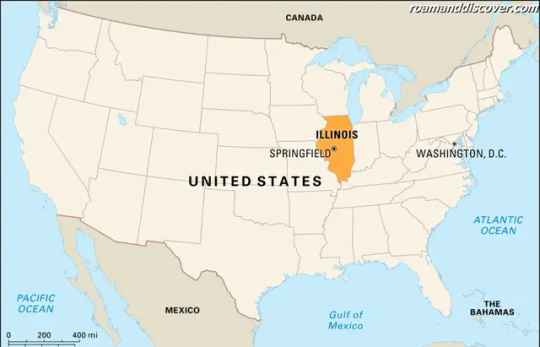
Etymology
The name 'Illinois' comes from the French rendering of the Algonquian language word for the Illinois Confederation, 'ilinwek' or 'illiniwek.' This name refers to a group of Native American tribes who lived in the region even before the arrival of European explorers. The meaning of 'ilinwek' is disputed, but it is commonly translated as 'tribe of superior men,' 'men of men,' or 'best people.' The Illinois Confederation was a loose alliance of several tribes, including the Cahokia, Kaskaskia, Peoria, and Tamaroa, among others. They inhabited the region around the Mississippi River, extending from present-day Illinois to parts of Wisconsin and Missouri. The name 'Illinois' was officially adopted as the state's name when it achieved statehood in 1818. It was chosen by the state's first governor, Shadrach Bond, who sought to honor the Native American tribes who had long inhabited the land.
History
Illinois has a rich and diverse history, dating back to precolonial times. Before European settlers arrived, the area was home to indigenous peoples, including the Illini, Miami, and Potawatomi tribes. In the years that followed, Illinois played a key role in the French and Indian War and the American Revolution. The state became part of the Northwest Territory in 1787 and was officially recognized as a state in 1818. Throughout the 19th century, Illinois grew rapidly, becoming a major hub for transportation and industrial development. The state was also notable for its involvement in the Underground Railroad, helping slaves escape to freedom in the north. In the early 20th century, Illinois was a key player in the labor movement, with major strikes and protests taking place in Chicago and other urban centers. The state also played a significant role in both World Wars, supplying troops and resources for the war effort. In the years that followed, Illinois continued to grow and evolve, with major advancements in industry and technology. The state was also marked by several notable political scandals, including the impeachment and removal of Governor Rod Blagojevich in 2009. Today, Illinois is a vibrant and diverse state, with a rich cultural heritage and thriving economy. Its history is woven throughout the fabric of the state, from its urban centers to its rural communities.
Geology
Illinois has a diverse geological landscape with various regions that all have their unique formations. One of the most notable geological features in Illinois is the Ozark Dome, a subterranean formation characterized by underground mines of lead, zinc, and other minerals. In contrast to this, the northwest and north-central region have mostly glacial formations such as drumlins, eskers, and moraines, created by the last ice age. The state has a rich history of coal mining that has left behind abandoned underground mines throughout the central part of the state. These coal deposits are from the Pennsylvanian period and are believed to have been formed about 300 million years ago. The coal-rich areas in Illinois are where the land is flat and the soil is fertile. Illinois has also been known to produce natural gas and petroleum, which has played a significant role in the industrialization and economic growth of the state. The reserves of natural gas and petroleum are found primarily in southern Illinois, in the Illinois Basin. The state has an extensive system of rivers and lakes, including the Mississippi, Illinois, Ohio, and Wabash rivers, that have played a significant role in shaping the geological makeup of Illinois. The contributions of these rivers and lakes have been significant in creating the rich farmland that exists in the state, aside from providing transportation for goods and services. the state of Illinois has a diverse geological landscape that ranges from underground mines that are rich in minerals to the flatlands that are suitable for farming. The state's history has been shaped by the natural resources found within its borders, with coal, natural gas, and petroleum being significant contributors to Illinois's industrialization. The region's numerous rivers and lakes have also had a remarkable impact on shaping the landscape and creating the fertile soil necessary for farming.
Geography
Illinois is a heavily populated state located in the Midwest of the United States. It is surrounded by Indiana to the east, Missouri to the west, Wisconsin to the north, and Kentucky to the south. The state is divided into three distinct regions: the Central Plains, Shawnee Hills, and the Illinois Ozarks. The Central Plains region consists of gently rolling hills and vast prairies with fertile soil, while the Shawnee Hills region is characterized by hills, bluffs, and forests. The Illinois Ozarks region, on the other hand, consists of rugged hills, ridges, and deep ravines. Illinois also houses several water bodies, including the Mississippi River, the Ohio River, and the Wabash River. The state also has many lakes, including Lake Michigan, which is the fifth-largest freshwater lake in the world by volume. The Chicago River also meanders through downtown Chicago to create an impressive sightseeing opportunity. The land use in Illinois is predominantly agricultural, with over 75% of the land used for farming purposes. The state is one of the largest producers of corn and soybeans in the United States. In addition to agriculture, the state is also known for its manufacturing and industrial capabilities. The major industrial centers in the state include Joliet, Rockford, Peoria, and Bloomington-Normal. Over the years, there has been a significant increase in urbanization and suburbanization in Illinois, primarily near Chicago, which is the largest city in the state. The state ranks fifth in the country in terms of urbanization, with over 87% of the population residing in urban areas. The state has an extensive transportation infrastructure network, including roads, highways, railways, and airports. The Illinois Tollway system covers over 292 miles of roadway to connect the major cities and metropolitan areas in the state. The Chicago O’Hare International Airport is the busiest airport in Illinois and one of the busiest in the United States. It serves over 83 million passengers every year. Illinois is also home to several protected areas and parks, including the Shawnee National Forest, the Illinois Beach State Park, the Starved Rock State Park, and the Lincoln Park Zoo. These parks offer visitors a glimpse of the state's natural beauty and biodiversity and are popular destinations for hiking, camping, and wildlife watching. the physical geography of Illinois is an interesting mix of rolling hills, deep ravines, forests, and water bodies. The state's land use is predominantly agricultural, with a growing urbanization trend near major cities. It has an extensive transportation network and offers numerous recreational and entertainment options for tourists. Illinois is indeed one of the most geographically diverse and culturally rich states in the United States.
Ecology
Illinois is a state filled with diverse ecology, with several major biomes present within its borders. Forests, grasslands, wetlands, rivers, lakes, and streams are all habitats for a wide variety of plants and animals. About 25% of the state remains forested, with the majority of it located in the southern part of the state. The state's wetlands play a crucial role in regulating water levels, filtering pollutants, and providing habitat and food for many species. Sadly, many of these biomes have been severely impacted by human activities such as development and farming. The Illinois Department of Natural Resources (IDNR) works tirelessly to preserve and maintain these natural areas. They have established numerous state parks, nature preserves, and wildlife refuges to protect habitats and support wildlife populations. the state has several programs to provide financial and technical support to landowners who wish to participate in conservation efforts. One of the most significant conservation challenges in Illinois is combating invasive species that threaten many of the state's native ecosystems. The state has established protocols to identify and remove these species, including the use of prescribed burns, herbicides, and other methods. The state is also working to address water quality concerns, particularly in the Illinois River. Agricultural runoff, sewage treatment discharge, and other pollutants have had a damaging effect on the river's ecology. The state is implementing a variety of measures to improve the water quality, including guidelines for agricultural practices, new wastewater treatment facilities, and river restoration projects. The state also recognizes the importance of protecting its endangered and threatened species. The Illinois Endangered Species Protection Board is responsible for developing and implementing plans to conserve and recover species on the brink of extinction in the state. Several species, such as the gray wolf, black bear, and mountain lion, have been eliminated from the state and are being considered for reintroduction. the state encourages residents and visitors to participate in conservation efforts and education programs. These programs provide opportunities for people to learn about the state's ecology, wildlife, and natural resources and how they can help protect them.
Biodiversity
Illinois boasts a diverse array of flora and fauna, with both native and introduced species inhabiting the state. Several types of forests, including oak-hickory and beech-maple, cover much of the state. The Illinois River, Lake Michigan, and other waterways are home to several species of fish, turtles, and amphibians. Moreover, Illinois' native plant life provides an important habitat for a variety of animals. Wildflowers such as purple coneflowers and wild lupine are often found on the state's prairies, providing food and shelter for animals ranging from bison to butterflies. Threatened or endangered species such as the Illinois mud turtle and Hine's emerald dragonfly call the state home, requiring conservation efforts to protect their habitats. In addition to the native species, Illinois has seen an influx of non-native species. Some species have been deliberately introduced due to their perceived benefits, while others have arrived unintentionally through human activities such as shipping and travel. However, non-native species can have negative impacts on the environment and native species, often outcompeting and marginalizing them. As a result, Illinois has regulations in place to prevent the introduction and spread of non-native species. Protecting Illinois' biodiversity is necessary to maintain the state's ecological health and promote its economic wellbeing. The state has established several programs to address conservation and restoration efforts, such as the Illinois Wildlife Action Plan and the Illinois Nature Preserves Commission. the state has regulations in place to protect threatened and endangered species and their habitats, as well as to prevent the introduction of non-native species that may threaten the native ecosystems. Furthermore, Illinois residents also play a critical role in the protection of the state's biodiversity. For example, homeowners can plant native species in their yards to provide habitat and food for local wildlife and can take steps to reduce their carbon footprint, aiding in the fight against climate change. Conservation organizations and volunteer groups also provide opportunities for citizens to get involved in restoration and conservation efforts across the state. Illinois' biodiversity is essential to its ecological and economic health. The state's rich natural resources provide habitat for a diverse array of native species, as well as several non-native species. However, conservation efforts are necessary to protect these resources and prevent the spread of non-native species. Through both governmental and individual actions, Illinois can continue to promote its ecological wellbeing while supporting its social and economic interests.

turtles
Climate
Illinois has a diverse climate due to its location in the central United States, bordering the Great Lakes region and stretching south to the Mississippi River. The state experiences all four seasons, with hot summers and cold winters. In the northern part of the state, the climate is considered humid continental, characterized by warm summers and cold winters with heavy snowfall. Average temperatures in January, the coldest month, range from 24°F to 30°F (-4°C to -1°C), while July, the warmest month, sees averages from 64°F to 82°F (18°C to 28°C). In central Illinois, the climate is also humid continental, but with warmer temperatures throughout the year. Summers are hot and humid with occasional thunderstorms, while winters are milder with less snowfall. Average temperatures in January range from 25°F to 33°F (-4°C to 0°C), while July sees averages from 65°F to 85°F (18°C to 29°C). Southern Illinois is located within the humid subtropical climate zone, characterized by hot summers and mild winters with occasional snowfall. Average temperatures in January range from 32°F to 40°F (0°C to 4°C), while July averages range from 69°F to 89°F (21°C to 32°C). Illinois sees its fair share of severe weather, including thunderstorms, tornadoes, and even blizzards in the winter. The state averages about 35 to 45 thunderstorm days per year, with potential for damaging winds, hail, and tornadoes. The peak tornado season is from March to June, with an average of 47 tornadoes per year. Due to its location near the Great Lakes and Mississippi River, Illinois also experiences lake-effect snow and flooding. In the winter, cold air over the Great Lakes travels south, picking up moisture and dumping heavy snow on coastal areas. In the spring, heavy rains can cause flash flooding, especially in the central and southern parts of the state. Illinois' climate varies depending on location, but the state experiences all four seasons with mild to hot summers and cold to mild winters. Visitors should always check the weather forecast and be prepared for any potential severe weather events.
Environmental issues
Illinois is faced with numerous environmental challenges and concerns. One of the major concerns is the issue of pollution, both air, and water pollution. There are multiple sources of pollution in Illinois, including industrial facilities, agriculture, and transportation. Industrial facilities such as power plants, refineries, and manufacturing plants release toxic pollutants into the air and water, which can be harmful to human health and the environment. Agricultural activities such as the use of pesticides and fertilizers in farming contribute to water pollution in the state. These chemicals find their way into streams and rivers, leading to increased algae growth and the death of aquatic life. Transportation is also a major source of air pollution in Illinois. The use of vehicles such as cars, trucks, and buses releases harmful pollutants into the air, leading to respiratory problems and other health issues. Another major concern in Illinois is climate change. The state has experienced extreme weather conditions in recent years, including floods, droughts, and severe storms. These extreme weather events have led to damages to infrastructure, crop losses, and human health problems. The state is taking measures to reduce greenhouse gas emissions and promote clean energy sources, but more needs to be done to mitigate the effects of climate change. Illinois also faces challenges in conserving its natural resources such as forests, wetlands, and wildlife. Deforestation, urbanization, and industrialization have led to the loss of important habitats and biodiversity. The state has established protected areas such as state parks and nature reserves, but these efforts are not enough to prevent the loss of wildlife and habitats. waste management is another major environmental concern in Illinois. The state produces a significant amount of waste yearly, and proper disposal and recycling methods are needed to prevent land and water pollution. The state has implemented waste reduction programs such as the Illinois Green Business Association to promote sustainable waste management practices. Illinois is faced with numerous environmental challenges and concerns, from pollution to climate change and natural resource conservation. The state government, together with stakeholders, is taking measures to address these issues, but concerted efforts are needed to ensure a sustainable environment for future generations. Read the full article
2 notes
·
View notes
Text
Exploring the Best Stay in White Town, Pondicherry: A Travel Guide
A travel destination for people from all over, Pondicherry with a French colonial touch is quite clean. White Town is a charming place at the heart of this beautiful city and if you take a trip over to it you will get a taste of the history it has to offer in the form of cobblestone streets, brightly painted houses and tranquil beaches. The best stay in White Town, Pondicherry can make any visit unforgettable for anyone who is looking for the best of staying experience.
Why White Town?
White Town is known for its cousin between Indian and French cultures. Pondicherry has a lot of heritage buildings and art galleries, lots of gorgeous cafés and the beautiful Promenade Beach all within this part of Pondicherry. Being here means being in the middle of all the action and still feeling peaceful. White Town is a great base for anyone — a history buff, a foodie, a nature lover — as you can be whatever you are. Your first priority while visiting White Town, Pondicherry should be to find the best stay in White Town so you can fully make the most of your time here.
Best Stay – What to Look For.
The best stay in White Town, Pondicherry varies from personal to personal. But, some key things should always be taken into account. This region has its fair share of heritage hotels and guesthouses, but all have a French flavor about them. Traditional design goes hand in hand with mod cons in these stays that often blend traditional design with modern amenities, making for comfort and luxury in a historical setting.
Proximity to Promenade Beach also plays a large part in the decision. The best stay in White Town, Pondicherry, will leave you wide awake in the morning listening to waves and walking along the coast right outside your room. Sea facing rooms are offered by many hotels and accommodations with you enjoying the breath-taking view of the Bay of Bengal right from your window.
Of course, if you are looking for something on the budget side, there are still plenty of boutique guesthouses and cosy homestays in White Town. If you are a traveller who desires to step into the local culture without going overboard on your budget, these are perfect! Don’t think the best stay in White Town, Pondicherry has to be a high end luxury hotel. Sometimes, the most memorable experiences are with simpler, more intimate set up.
Best Stay Recommendations
To help you find the best stay in White Town, Pondicherry, here are some popular options that offer a mix of heritage, comfort, and convenience:
Palais de Mahe: A luxury heritage hotel featuring spacious rooms, a rooftop restaurant and a pool, featuring French colonial architecture. It’s literally close to the fantastic Promenade Beach.
Villa Shanti: In doing so, this boutique hotel is contemporary — but with a traditional vibe. Comfortable rooms, a quiet courtyard, an in house restaurant serving delicious French and Indian cuisine are some of the things it has to offer.
La Closerie: A charming guesthouse with pool and beautifully designed rooms. For this peace seeker, peaceful homely stay within White Town as the shelter option it's a great option.
Le Dupleix: Le Dupleix, another heritage property is a combination of the luxury and history. It offers colonial architecture, modern facilities and is suitable for the travelers who want to go with the elegance and comfort.
In short, if you’re looking for the best stay in white town Pondicherry , one should consider the balance of preferences, including, luxury, proximity to attractions or budget per se. White Town’s culture and beauty no matter where you stay will stay in your memory.
0 notes
Text
Gets Holiday India Tour's car tour of the Taj Mahal Sunrise
One of the Seven Wonders of the World and a symbol of love, the Taj Mahal provides a beautiful sunrise view that one should see at least once in a lifetime. Reputable travel business Gets Holiday India Tour promises a comfortable, historical, and beautiful automobile tour of the Taj Mahal Sunrise. In addition to showcasing the magnificent Taj Mahal in the gentle morning light, our tour offers a thorough travel experience enhanced with historical context and cultural understanding.
The Benefits of Choosing a Sunrise Tour
There's nothing like seeing the Taj Mahal at first light. The white marble's elaborate patterns and the priceless stones set into its walls are accentuated by the gentle, golden light of the early morning. Viewing is peaceful and private because of the morning's lower temperatures and generally empty surroundings.
An Overview of the India Tour Company Gets Holiday
Gets Holiday India Tour is well known for its painstakingly organized trips and top-notch client support. The company's mission is to provide unforgettable experiences. To that end, it makes sure every tour is both immersive and instructive, offering in-depth explorations of India's rich cultural heritage.
Organizing Your Tour of Sunrise
Ideal Time to Go
October through March are the ideal months to start this trek because of the most favorable weather. But the Taj Mahal's attraction never goes away—every season presents a different angle on this marvel of architecture.
What to Anticipate
A Brief Look at the Past
The trip provides in-depth explanations of the history, building, and love tale that inspired the Taj Mahal. The Mughal era's creative and architectural skill is demonstrated by this famous structure.
Feeling the Beauty
Witness the Taj Mahal's color changes as the sun rises—it's a really breathtaking sight. It is possible to think and appreciate the monument's beauty as well as the love story it symbolizes in the serene morning air.
The Adventure Starts
Point of Departure
The tour usually starts in New Delhi and travels to Agra, the home of the Taj Mahal, via a pleasant car ride. A portion of the experience includes the travel, which provides views of India's varied terrain and way of life.
The Path
With possible stops at historical landmarks and regional restaurants that provide a taste of India's many culinary traditions, the journey to Agra is just as fascinating as the destination itself.
Tour Highlights
Magnificent Scenes at Dawn
Without a doubt, the most breathtaking sight is when the Taj Mahal is illuminated by the first rays of morning. It is a moment that is both humble and inspiring.
Features of a Guided Tour
The experience is enhanced by knowledgeable guides who share information on the Mughal Empire, the history of its building, and the architectural features of the Taj Mahal.
Advice for Vacationers
What to Pack
The Taj Mahal is a tomb, so bear that in mind when you dress modestly, bring your camera, and choose comfortable shoes.
Culturally Specific Issues
Traveling is made more enjoyable and meaningful when you are aware of and respectful of the customs and traditions of the locations you visit and the people you meet.
In summary
More than just a trip to a historical site, the Gets Holiday India Tour's vehicle Taj Mahal Sunrise Tour is a comprehensive experience that provides a singular fusion of beauty, history, and culture. This tour promises lifelong experiences, whether you're a history buff, a photography enthusiast, or just looking to see one of the most well-known landmarks in the world in a different way.
FAQs
How long does the Taj Mahal Sunrise Tour last? Does the tour package include admission to the Taj Mahal? Is it possible to tailor the tour for specific events? What safety precautions are in place for COVID-19? How can I make a reservation for Gets Holiday India Tour's Taj Mahal Sunrise Tour? With Gets Holiday India Tour, take in the majesty of the Taj Mahal at dawn on a journey that is sure to be as remarkable as the monument itself.
Click here to get access now:https://getsholidayindiatour.com/sunrise-taj-mahal-tour/
Taj Mahal Sunrise Tour By Car
Overview
Skip The Line
Duration: 01 Day
Free cancellation
Instant Confirmation
Private Tour
As you know India is rich in religion and its culture. There are so many beautiful places in India, from them Taj Mahal is one of the seven wonders in the World. Taj Mahal laid in the bank of Yamuna River northern state of Uttar Pradesh. Agra is a major tourist destination among India. Agra has 3 or 4 major tourist attraction like Agra Fort, Taj Mahal, Fatehpur Sikari��and Baby Taj. We provide you best Taj Mahal Sunrise Tour By Car from Delhi with great experience. Book Taj Mahal Sunrise Tour By Car from Delhi now and get instant benefits.
Itinerary
02:30 hour's - Pickup From Delhi
06:00 hour's - Taj Mahal
08:30 hour's - Breakfast
09:30 hour's - Agra Fort
11:00 hour's - Itimad-Ud-Daulah
12:00 hour's - Mehtab Bagh
13:00 hour's - Drop Back
What's Included
Inclusions
Air conditioned chauffeur driven private car
Pick up and Drop
Story teller tour guide
All toll taxes, parking fee, camera fee
Lunch at a restaurant
Monument tickets
Exclusions
Gratuties
Any sort of drinks
personal expenses
0 notes
Text
The Ultimate Guide to Caribbean Cruises: Your Passport to Paradise

When winter's chill has you wrapped in layers of wool and fleece, it's time to swap your snow boots for flip-flops and your hot cocoa for a tropical piña colada. Welcome to the world of Caribbean cruising—a floating paradise that offers the perfect antidote to the winter blues. This comprehensive guide will walk you through everything you need to know to make your Caribbean cruise a journey of a lifetime. Why Choose a Caribbean Cruise? Imagine a vacation where you can explore multiple destinations without the hassle of packing and unpacking, or checking in and out of hotels. A Caribbean cruise offers you the best of both worlds: the diversity of visiting several islands and the luxury of a floating hotel that takes you there. You'll experience a seamless blend of comfort, convenience, and adventure, all wrapped up in one unforgettable package. The Fleet: From Floating Cities to Intimate Yachts The Caribbean cruise landscape is as diverse as the islands themselves. Ships range from colossal floating cities capable of hosting up to 6,000 guests to intimate yachts that accommodate as few as 16. Each ship offers a unique atmosphere: - Mega-Ships: Think of these as floating resorts, complete with multiple dining options, entertainment venues, and recreational activities. Perfect for those who love a bustling environment. - Mid-Size Ships: Offering a balance between amenities and a more personal experience, these ships are ideal for travelers who want a bit of everything. - Small Ships: These offer an intimate, luxurious experience, often venturing to less-visited ports that larger ships can't access. What's Your Vibe? The ambiance varies significantly from one ship to another. Some ships are party central with Top 40 hits blaring by the pool, while others offer a more refined experience with black-tie events and classical music. Adventure-seekers will find ships loaded with activities like water slides, rock climbing, and snorkeling excursions. Some even offer themed cruises that focus on the culture, history, or ecology of the destinations they visit. Navigating the Caribbean Archipelago The Caribbean is a sprawling tapestry of over 700 islands, each with its own unique charm. The region's name originates from the Carib people, the indigenous inhabitants who first met Europeans in the late 15th century. Post-Columbus, the islands were initially known as "the Antilles," a term that still holds sway alongside "the Caribbean." Greater Antilles vs. Lesser Antilles The Caribbean islands are broadly categorized into the Greater and Lesser Antilles: - Greater Antilles: Includes popular destinations like Grand Cayman, Montego Bay in Jamaica, Puerto Plata in the Dominican Republic, and San Juan in Puerto Rico. - Lesser Antilles: A melting pot of Dutch, French, English, and Spanish influences, featuring ports like St. Martin, Martinique, St. Lucia, St. Barth, Aruba, Trinidad, and Tobago. Mainland Ports Don't overlook mainland ports like Costa Maya and Cozumel in Mexico, or Belize and Honduras. These destinations offer a rich tapestry of cultural, ecological, and geographical diversity. Tailoring Your Experience Before booking, ask yourself: - What size ship suits you? - What kind of shore excursions interest you? - What level of service do you expect? - What amenities do you want included in your package? Activities for Every Adventurer Whether you're a beach bum or a history buff, the Caribbean has something for everyone. From the pristine white sands and crystal-clear waters to mountainous terrains and lush rainforests, the options are endless. Don't miss out on rum tasting tours, archeological expeditions, or local culinary delights like conch fritters. Hotel Options While your cruise ship will serve as your primary accommodation, you might want to extend your trip with a hotel stay. Here are some options: - Ritz-Carlton, Grand Cayman - Sandals Montego Bay, Jamaica - Condado Vanderbilt Hotel, San Juan, Puerto Rico Best Tours to Consider - Grand Cayman Stingray City Tour - Montego Bay Catamaran Cruise - San Juan Historical Walking Tour Embarking on a Caribbean cruise is like holding a passport to paradise. So, what are you waiting for? Cast off those winter blues and set sail for an unforgettable adventure. For more travel tips and guides, visit InvestingTravels.com. Read the full article
0 notes
Text
Traditional Country Rice Products in India
TRADITIONAL RICE
Red. Brown. Pink. Black. Buff and of course, white. These vibrant shades have given the world distinct flavours of rice for generations. With the advent of modern technology and the rapid need to feed growing populations, mass processing became necessary and thus was born the uniform white rice that is consumed by most people all over the world.
History
The history of rice dates back to before the Common Era, and is now widely believed to have grown as a kind of wild grass in the foothills of the Himalayas. Alexander’s trans-continental expedition took rice back into Greece from where it entered Europe. Rice made its way to the Americas only with Columbus’ expedition; it was only in the seventeenth century that South America witnessed the wonder-crop that is rice. Traditionally, there are 24 different species of rice grown across India. Of these, 21 varieties are wild, whilst two have been domesticated in India. Of these species, there are hundreds of varieties in each. Karnataka alone is home to more than 700 varieties of rice!

Different rice for different meals
Each of these varieties has a specific geographical, cultural and gastronomic significance. Different colours, the lengths of grain, the planting-to-harvest cycle, are all varied and differ from rice to rice. When it comes to food, each of these rice varieties are also intended for a particular kind of meal. The rice used to make certain foods such as idli, belong to a separate species. Pongal meant a different rice variety.
So what did this amount to?
Using different kinds of rice traditionally grown in the local geographical area meant that consumption was in harmony with the immediate environment. It also met the micro-nutrient profile for every individual. The traditional rice varieties are packed with fibre and minerals. Polishing them takes away all these benefits. It also impairs the flavour in every dish.
But what is with the different shades of rice that are now gaining popularity?
Every bowl of coloured rice comes with a unique dietary promise.
Colours in rice
Brown rice:Rice grains are rich in a wide variety of nutrients. Brown rice is rice that has not undergone any kind of processing, thereby helping the nutrients remain intact in every grain of rice. Brown rice must usually be soaked before cooking and tends to get mushy with overcooking. It offers a low glycaemic index and is ideal for diabetics.
Red rice:Kerala is known to be the home of several red rice varieties. Every region in Kerala has its own varieties and in turn, each kind is used for a specific kind of food. Navara is a medicinal rice and is often prescribed in Ayurveda for a variety of ailments. Kuruva, Chitteni, and others abound in different regions of Kerala. For Tamil Nadu, it is the mapillai champa that is rapidly gaining popularity after years of being relegated to the background. Rajamudi is believed to have been exclusively grown for the Wodeyar kings in the Mysore area.
Black rice:The kavuni variety of rices, most popularly, karungavuni, is a medicinal black rice used in Tamil Nadu. Black rice has been a popular choice in the Far East, and food historians cite ample reason to believe that the black rice may have made its way into India through Burma and Malaysia—these may have been brought back by business families with interests there or indentured labour who came back to the sub-continent.
Fragrant rice:Up until the organic revolution that has taken the country by storm, the only known varieties of fragrant rice have been the Basmati and the jeeraga samba. However, traditionally grown fragrant rice varieties abound in different regions of the country. The eastern belt, particularly Bengal and Orissa are famous for the gobinda bhog variety, and foods made from this rice are used as temple offerings.
What we lose without traditional rice?
The inexhaustible variety of cuisines that India has to offer is reason enough for us to try different rice varieties for different foods. In depriving our homes of this abundance near us, we are consciously choosing to have a homogenous interpretation of all that food is. Traditional rice varieties bring us fibre, micro-nutrients, unique flavours and therefore, unique food experiences.
Roots Veyr brings you all these hand-picked varieties, organically grown and ethically sourced. Choose from our list Here
Read more posts
Goodness of Pure A2 Desi Ghee
Lemongrass Tea - a closer look
The Health Benefits of Honey
2 notes
·
View notes
Text
Jaipur

Known in the world of tourism as the Pink City, Jaipur stuns all with its characteristic feminine hue. It is a pleasant sight to behold against the backdrop of the imposing Nahargarh and Jaigarh forts. It combines its historical allure with all the features of an Indian metropolis.
Jaipur is one corner of the famous Golden Triangle of India, the other two being Delhi and Agra. When you plan a trip to Rajasthan, Jaipur is always an essential part of your itinerary. There are so many attractions here itself that you can expect to spend at least three days in the Pink City.
Best time to Visit Jaipur
India has three main seasons, namely summer, winter and monsoon. The quality of your Indian trips is often decided by the weather. We have given here a brief description of best time to visit Jaipur in all the three seasons.
Summer: -
Summers in Jaipur start from mid-March and last till June. Rajasthan has an arid climate and technically, is best avoided during high temperatures. It is hot and dry throughout the day, and as a tourist unused to the harsh weather, you are more susceptible to dehydration and fatigue. If you are visiting Jaipur during the summer, be sure to pick air-conditioned transport. Always keep a bottle of water and snacks handy.
Monsoons: -
The Jaipur rains start from July and last till September. It is quite a pleasant time to visit if you love the rain and to be in nature. The city of Jaipur takes on a fresh green look during the monsoons. August witnesses the highest amount of rainfall in the four months of the season. A Jaipur trip will be more budget-friendly and less crowded if you visit during the monsoons. You will also get a chance to visit some local festivals such as Teej.
Winter: -
Winters are quite the opportune time to visit Rajasthan. The nights are bitterly cold, but it is manageable for the sake of basking in the winter sunshine that envelops Jaipur during the day. Precisely why the best season to visit Jaipur is winters. It lasts from October to March and is the peak tourist season. Jaipur in January is a must-visit for bookworms, because of the annual Literary Fest. Even if you are not very keen on books, there are a plethora of other activities to keep you occupied elsewhere in the city.
Here is a quick summary of all the seasonal details…
SUMMER
March to June - 34˚C to 45˚C
MONSOONS
July to September - 27˚c to 34˚C
WINTERS
October to March - 5˚C to 32˚C (can drop to 0˚C at night)
How to Reach: -
Thanks to India’s transport and travel network, most of the big cities are very well connected to each other. Jaipur, being the capital city of Rajasthan, has no dearth of travel services either. Although your Jaipur tour package would have all the information, here is what you must know prior to visiting the tourism board –
By Air: -
The Sanganer Airport in Jaipur is well connected with Indian metropolitans and the Middle East through the Air India, GoAir and Jet Airways airlines. The approximate travel time to Jaipur from major Indian cities like Mumbai, Delhi, and Kolkata are 2 hours and 10 minutes.
By Rail: -
Indian Railways is a vast operation to connect even the remotest parts of the country. Rajasthan, therefore, it is very well connected to the rest of India by train as well. Again, the approximate travel time varies widely and depends upon the starting point. If you are traveling from Delhi, you will need just 4 hours. However, to travel from Chennai to Jaipur by train, you may need 36-37 hours.
By Road: -
Rajasthan boasts of well-maintained National Highways out of which NH8 is the preferred one if you want to travel by road. The two most common modes of transport are usually buses or private cars while going to Jaipur. The travel time can again vary from 5 hours to 24 hours, depending on the starting point of your ride, in this case, Delhi and Mumbai respectively.
Places to Visit in Jaipur: -
Rajasthan is known as one of the best travel destinations of India. Jaipur is the capital city and thus boasts of many magnificent palaces and forts built by the Rajasthan Royals. It is a hotspot for history lovers who want to imagine the days long gone exactly as they were before. Here are some popular places which should be part of your Jaipur trip package:
City Palace: -
The City Palace is located in the heart of Jaipur and dates back to the 19th century. It is a marvelous blend of Rajput, Mughal and European styles of architecture. Many parts of the palace complex have been converted into art galleries and museums so that the visitors can see for themselves the royal lifestyle of the kings and queens of the city. Chandra Mahal within the City Palace complex serves as the residence for the current royal family of Jaipur.
Hawa Mahal: -
The Hawa Mahal is a palace constructed in the middle of the bustling city and is a very prominent landmark in the Pink City. It has plenty of jharokas or small windows so that the ladies of the royal family could observe the daily comings-and-goings of the city while remaining invisible to the common man. The Hawa Mahal is built of red and pink sandstone, and the structure allows complete ventilation even during peak summers. That is why it is named Hawa Mahal or the Palace of Winds.

Image Source: -
https://pixabay.com/en/palace-of-winds-india-jaipur-1882851/
Jantar Mantar: -
In stark contrast to the opulent palaces of the city, Jantar Mantar is a science observatory in Jaipur. It lauds the astronomical skills of Maharaja Sawai Jai Singh at a time when the science itself was very new to the world. Different astronomical instruments made of stone and brass are fixed on the ground, and hundreds of curious tourists can observe numerous astrological positions with the naked eye. The Samrat Yantra in the observatory is the world’s largest sundial till date and deserves a special mention. It is indeed an astronomical heritage of not just Jaipur but entire India in an era when we are giving up our Indian culture.
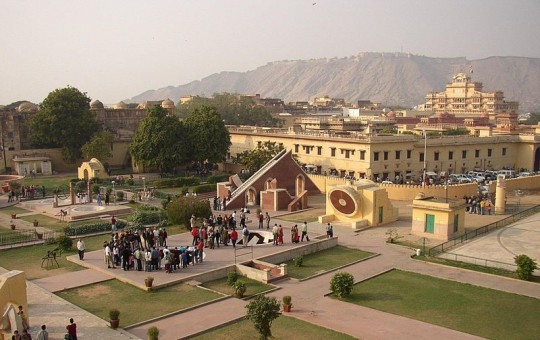
Image Source:-
https://hi.wikipedia.org/wiki/Jantar_Mantar_at_Jaipur.jpg
Amer Fort: -
The Amer Fort is located in Amer town, at a distance of 11 kilometers from Jaipur. It was constructed by Raja Man Singh I and is a brilliant example of Rajput architecture. It also offers breathtaking views of the surrounding hills and cities. Many famous Bollywood movies such as Jodhaa Akbar, Mughal-E-Azam and Veer have been shot here. It overlooks the serene Maota Lake and is visited by umpteen visitors every year.
Things to Do in Jaipur: -
Jaipur is a perfect mélange of history and modernity. Don’t fret if you’re not a history buff; we have got you covered. How would you like to gorge yourself on some delicious Rajasthani meals, or shop till you drop? Read on… We have listed the top and amazing things to do in Jaipur:
Enjoy the Sights at the Jal Mahal: -
You have to see it to believe it. The Jal Mahal is actually built in the middle of the Mansagar Lake nestled between the Nahargarh Hills. It is built with an exotic flair of both Mughal and Rajput architecture. Initially used as a summer retreat by the royal family, the Jal Mahal is now a tourist attraction. You can relax by the side of the lake to feel the cool breeze and take some really amazing photos of the palace as the sun disappears behind the hills.
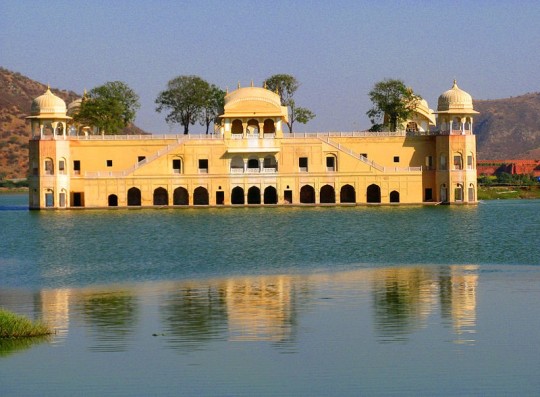
Image Source: -
https://commons.wikimedia.org/wiki/File:Jal_Mahal_Jaipur_City.jpg
Elephant Ride At Amer Fort: -
A visit to the golden Amer Fort is incomplete without an elephant ride. You can explore the huge gateways and cobbled paths of the fort while sitting upon the very animal which once graced the royal stables. Be sure to go for the ride in the mornings, as the elephants are well-rested then and you will have an enjoyable experience.
Choki Dhani: -
If you are a foodie, this is the place for you. This village resort offers you the best of Jaipur with puppet shows, folk music, acrobatics and of course, delicious Rajasthani food. Tuck into the mouthwatering dishes at the open air restaurants while you take in the electrifying ambiance of Choki Dhani. It is a perfect break from the city life with its rustic appeal and natural surroundings.
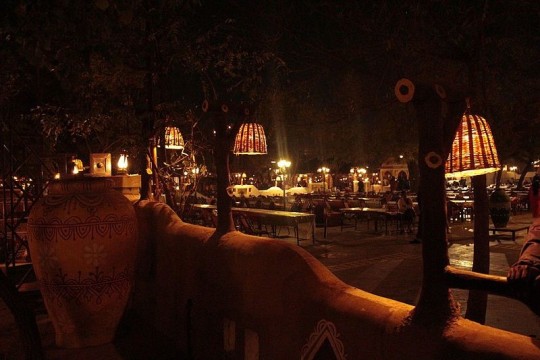
Image Source: -
https://hi.wikipedia.org/wiki/Chokhi_dhani.jpg
Shopping In Jaipur: -
Johri Bazaar in Jaipur is a perfect representation of the city. Most of the shops are painted pink, and you will get all the trinkets you want here. You can take your pick from dresses to jewelry and even Jaipuri quilts. Kundan jewelry is very popular in Rajasthan, and you will find a lot of it at Johri Bazaar. Believe me; a nice traditional bracelet can make all the difference in the world to your jeans-and-tee-shirt ensemble.
Festivals and Events: -
India is a land of festivals, and Rajasthan more so because of its deep connections with its past. Most of the festivals and events in Jaipur revolve around their regional beliefs and old Indian traditions. Some of the most popular festivals are described below. Joyous Jaipur’s festivals one need to be part of:
The Elephant Festival: -
Celebrated every year in the months of February and March, the Elephant festival is unique to Jaipur and is worth a watch. It is celebrated on Phalgun Poornima. Elephants are decked up beautifully and taken out in processions. The highlights of this festival are the elephant dances, elephant polo, and the tug-of-war between elephants and the people present at the festival.

Image Source: -
https://commons.wikimedia.org/wiki/File:Elephant_polo.jpg
Teej Festival: -
Teej is an important festival for the ladies of Jaipur. All the women dress in traditional attires and wear jewelry. Married women fast and pray for the long lives of their husbands, while unmarried girls pray to find a desirable match. People gather in temples to pray to Goddess Parvati. A number of folk dances and traditional songs are presented on this day.
The Kite Festival: -
The kite festival is held in Jaipur on the 14th of January every year. There is a myriad of colorful kites in the sky during the day. At night, tiny lamps are attached to the kites flown which then make for an alluring sight in the deepening twilight. A number of kite flying competitions are held. People also take a dip in the holy river Ganga to purify themselves.
Jaipur Literature Festival: -
The Jaipur Literature Festival was started in 2006 and is the biggest literary fest today in the Asia Pacific. It is a five day festival in January and is attended by both Indian and foreign authors who indulge in reading and discussion sessions. The audience has a chance to get autographed books. In the evenings, various musical shows are held. The literary festival is a must visit if you are a bookworm.
Food in Jaipur: -
Inhospitable Rajasthan, you will find all cuisines adapted to your liking. Rajasthan’s own food is very delicious and is definitely recommended to all tourists. The most popular food of Rajasthan is undoubtedly dal-baati-churma and lalmass (red meat) along with ghewar, a sweetmeat.
You can check out various cafes in Jaipur such as the Anokhi Café and Spice Court if you want to sample the Rajasthani fare. There are restaurants such as Jaipur Modern Kitchen and Brown Sugar if you just want to hang out and have continental snacks. Of course, you have options like the Cinnamon (Taj) and the Suvarna Mahal if you prefer a sophisticated meal setting. And if you are like most Indians, be sure to visit Fashion Street and Bapu Bazaar for street food that will tickle your taste buds.

Image Source: -
https://hi.m.wikipedia.org/wiki/Tastes_from_Rajasthan.jpg
Well, what are you waiting for? Get the best offer on the Jaipur tour package , pack your bags, book your tickets, and come straight to the Land of Kings…where no tourist is less than a king himself.
#best time to visit jaipur#best season to visit jaipur#jaipur tour package#jaipur holiday package#jaipur trip package
1 note
·
View note
Text
Third-Partystravaganza 7: Ancestral Warrior (Skald Archetype; Ascension Games)
A major part of the skald class has always been the recording of the legends passed down through the generations, as well as witnessing and contributing to new ones.
One such common legacy is that of the heirloom weapon, a weapon with a legacy that has been passed down through the generations. Such weapons are often either dormantly magical, with the might of the wielder unlocking past power, or are so soaked with history and the psychic echoes of past wielders that they have gained a measure of power.
Ancestral warriors are those who have been chosen to wield such a weapon, whether as a hereditary legacy or as a great honor from another clan. Whether they were initially skalds before acquiring the weapon, or they were trained as such upon receiving it likely varies by individual, circumstance, and culture.
Bound by its history and sacred rituals, the weapon of these warriors grows as they do, and can repair itself each day as they prepare their spells, and can be reconjured with an expensive ritual if it is ever lost or utterly destroyed. However, failure to protect such an important relic could risk it being revoked.
Rather than inspire allies to fury and battle-lust, these skalds call upon the martial prowess of warriors that have come before, blessing allies with guidance when attacking, defending, or using skilled techniques, whichever the ancestral warrior focuses upon.
Additionally, these warriors have an expanded knowledge of various combat techniques, putting them to use in battle.
When inspiring their allies, their weapon blazes with power, awakening various temporary magical enchantments that only grow in number and potency as they master their art.
With such a strong connection to the warriors of the past, it is no small wonder that these warriors can call upon the most knowledgeable among them, speaking across the multiverse to ask for their advice.
More powerful members of these magical warriors can cause their allies’ weapons to resonate with the power of their own, also carrying a shred of temporary enchantment.
The most powerful, however, are able to bless their allies with the greatest enchantments of heroism and might, bolstering them in body and mind for an extended period, though only once a day.
As a skald archetype, it also recommends several useful and thematic rage powers, mostly those that clear and ward the mind, help keep the beneficiaries alive, as well as the spirit totem, granting them and their allies a bevy of invisible spirit allies to support them.
If you’re looking for a skald themed around a powerful weapon, while still providing support for allies, this archetype may have what you’re looking for. I recommend a standard skald build, adjusting for the bonus combat feats and whatever strategies favor the type of weapon they favor. Focus on reading the situation to provide buffs that support your allies the best, and wading into combat to punish foes with spell and blade.
This archetype is great for emulating stories of young heroes being gifted a magical weapon which bestows upon them awesome powers when they hold it aloft. Of course, the same could be said of the bladebound magus as well. Whichever one fits your needs better, you should consider using, as both have their merits.
Claimed from the stomach of a black dragon, the Bileglass is the cracked remains of a crystal ball set into a handle, used as a crude greatclub by Ergra Dragonripper. Now, the weapon sits in the family cairn, awaiting when a brave scion of the clan comes to face the trials within and claim it, awakening its former power.
Roaming the temperate planes of the Voranos, the Skysinger tribe worships the tumultuous thunderstorms that rage throughout the year in their homeland, and sport many a sylph member as a result of their efforts to court the powers of air, (both in a metaphysical and romantic sense) many of which hold a tradition of the ancestor’s spear, bearing such a weapon past down for generations, calling upon the wind to bless it with the power of lightning and thunder.
The people of the Oceanfang Archipelago have long maintained relics of their oldest ancestors, including the brutal picks made traditionally from the stingers of the gigantic scorpions native to the region, but also sometimes from the volcanic glass viridium. As a trial of honor, a prospective wielder of such a weapon must face off against a beast of the ocean and slay it with the weapon.
#pathfinder#archetype#skald#ancestral warrior#third party#Ascension Games#Path of Iron#black dragon#dragon#sylph
16 notes
·
View notes
Text
Reasons to visit Israel
First and foremost, I really love travelling. Going to other places, seeing beautiful creatures especially to places that are rich in culture and heritage. I haven’t been to Israel before but when I finish my studies ang get a nice job, I’ll save money because I really want to visit Israel, especially to the places where Jesus was crucified. There are many Biblical sites or places in Israel and I would love to visit those places soon, in the right time. Israel is a complex, intriguing, and significant state to visit no matter your background. The region draws travelers worldwide who come out of interest, religious pilgrimage, or to simply have a luxurious vacation. From desert to sea, Israel is anything but boring. Those who visit gain a deeper understanding of life in one of the world’s most complicated places, and are sure to have an experience of a lifetime. Adventure travelers will feel a thrill exploring Israel’s vast range of natural features, history buffs will get their fix among ancient ruins, foodies must try hummus flavored ice cream, and religious travelers will find deeper meaning.
But before that, I will be listing the places that you should or you must visit in Israel:
1. “Acre – North Israel”
- A variety of different cultures have inhabited Acre throughout its history, including the Crusaders and the Ottomans, each leaving their mark on this region. With interesting, culturally molded buildings, ruins and sights around every corner, Acre is a must-visit location in the north of Israel. Enjoy a romantic evening walk along the port, have a meal at one of the local restaurants or take a relaxed stroll through Acre’s markets. A rarely visited site in Israel, this amazing old city offers the best of the old and new world: great restaurants perched on its seaside cliffs and even a world-class hotel alongside all the fun of a classic Arabic market.
2. “Sea of Galilee”
- The Sea of Galilee, or as Israelis call it, the Kinneret, is a major water source, as well as the largest freshwater lake, in Israel. The history of the lake goes way back. According to the New Testament, many of Jesus’ miracles occurred here, including his walk on the water. Today, tourists visit The Sea of Galilee to enjoy the relaxing lake, have fun building rafts, or practice various water activities. Called the Sea of Galilee by Israelis, Lake Kinneret is the site where Jesus is said to have walked on water. It’s also Israel’s main reservoir and a favorite tourist attraction for locals, who can regularly be found basking along its beaches.
3. “Golan Heights”
- In the north of the country you can find Golan Heights, a mountainous region with breathtaking landscapes, wonderful nature reserves and intriguing historical attractions for the whole family. If you’re interested in hiking, the Golan region offers a variety of different paths with varying levels of difficulty, dependent on the time of year. It is especially impressive during spring, when flowers are blooming and the fields are green. In wintertime, the Hermon Mountain, located in the Golan Heights, is an ideal destination for skiers.
4. “Masada”
- This mountaintop fortress in the Israeli desert was once the last holdout for the members of the Jewish revolt against the Roman empire. Their fate was a bitter one after a lengthy siege they decided to take their own lives rather than surrender but visiting the site is anything but bitter. Wake up extra early and hike or just take the tram and enjoy this amazing historical site. Masada is an ancient fortress in southern Israel’s Judean Desert. It's on a massive plateau overlooking the Dead Sea. Among the ruins are King Herod's Palace, which sprawls over 3 rock terraces, and a Roman-style bathhouse with mosaic floors. The Masada Museum has archaeological exhibits and recreations of historical scenes.
5. “Dome of the Rock”
- The Dome of the Rock is an Islamic shrine located on the Temple Mount in the Old City of Jerusalem. The Dome of the Rock is in its core one of the oldest extant works of Islamic architecture. Its architecture and mosaics were patterned after nearby Byzantine churches and palaces, although its outside appearance has been significantly changed in the Ottoman period and again in the modern period, notably with the addition of the gold-plated roof, in 1959 to 1961 and again in 1993. The octagonal plan of the structure may have been influenced by the Byzantine Church of the Seat of Mary built between 451 and 458 on the road between Jerusalem and Bethlehem. The Foundation Stone the temple was built over bears great significance in the Abrahamic religions as the place where God created the world and the first human, Adam.
6. “The Israel Museum”
- The Israel Museum was established in 1965 as Israel's foremost cultural institution and one of the world’s leading encyclopedic museums. It is situated on a hill in the Givat Ram neighborhood of Jerusalem, adjacent to the Bible Lands Museum, the Knesset, the Israeli Supreme Court, and the Hebrew University of Jerusalem. Its holdings include the world’s most comprehensive collections of the archaeology of the Holy Land, and Jewish Art and Life, as well as significant and extensive holdings in the Fine Arts, the latter encompassing eleven separate departments: Israeli Art; European Art; Modern Art; Contemporary Art; Prints and Drawings; Photography; Design and Architecture; Asian Art; African Art; Oceanic Art; and Arts of the Americas. Among the unique objects on display are the Venus of Berekhat Ram; the interior of a 1736 Zedek ve Shalom synagogue from Suriname; necklaces are worn by Jewish brides in Yemen; a mosaic Islamic prayer niche from 17th-century Persia; and a nail attesting to the practice of crucifixion in Jesus’ time.
7. “Dead Sea”
- It is also called Salt Sea, landlocked salt lake between Israel and Jordan in southwestern Asia. Its eastern shore belongs to Jordan, and the southern half of its western shore belongs to Israel. The northern half of the western shore lies within the Palestinian West Bank and has been under Israeli occupation since the 1967 Arab-Israeli war. The Jordan River, from which the Dead Sea receives nearly all its water, flows from the north into the lake. The Dead Sea has the lowest elevation and is the lowest body of water on the surface of Earth. For several decades in the mid-20th century, the standard value given for the surface level of the lake was some 1,300 feet or 400 meters below sea level.
8. “Mount Zion”
- Mount Zion is a hill in Jerusalem, located just outside the walls of the Old City. The term Mount Zion has been used in the Hebrew Bible first for the City of David and later for the Temple Mount, but its meaning has shifted and it is now used as the name of ancient Jerusalem's Western Hill. Mount Zion has been holy to Jews, Christians, and Muslims for hundreds of years. The people who live and work here represent the cultural diversity of the area and of Jerusalem as a whole. The Window to Mount Zion site created an interactive, online communal guide that features local people telling the story of Mount Zion from their perspective. In addition, you can find useful and historical information about Mount Zion.
9. “City of David”
- The City of David, a neighborhood of Silwan, is a Palestinian Arab village intertwined with an Israeli settlement, and the archaeological site which is speculated to constitute the original settlement core of Bronze and Iron Age Jerusalem. The international community regards Israeli settlements illegal under international law, although Israel disputes this. Archaeologically it is best known for its Canaanite infrastructure dated to the Middle Bronze Age, and its newer structures from the Iron Age, built by Judean kings. Organised as an Israeli national park, its management was taken over in 1997 by the Ir David Foundation.
10. “Al-Aqsa Mosque”
- Al-Aqsa Mosque, located in the Old City of Jerusalem, is the third holiest site in Islam. The mosque was built on top of the Temple Mount, known as the Al Aqsa Compound or Haram esh-Sharif in Islam. Muslims believe that Muhammad was transported from the Great Mosque of Mecca to al-Aqsa during the Night Journey. Islamic tradition holds that Muhammad led prayers towards this site until the 17th month after his migration from Mecca to Medina, when Allah directed him to turn towards the Kaaba in Mecca. Another earthquake destroyed most of al-Aqsa in 1033, but two years later the Fatimid caliph Ali az-Zahir built another mosque whose outline is preserved in the current structure. The mosaics on the arch at the qibla end of the nave also go back to his time.
These places are very worth it to visit, because you will see the Biblical sites in real life and you can see that God is really good and very imaginative and creative. If you love travelling, I encourage you to visit first these places in Israel before visiting other nice places because we don’t know when we will die and you will miss the opportunity to visit those holy places and to know and to witness what happened in those places before.
0 notes
Text
The Only Common Denominator of American Conservatism is Anti-Blackness | Religion Dispatches

“[T]he North has as much to apprehend from abolition as the South…and it is time for conservatives every where to unite in efforts to suppress and extinguish it.” — George Fitzhugh, Cannibals All! or, Slaves Without Masters, 1857
“Conservative” is a misnomer. The term obscures the fact that those identified as conservatives have varied more widely in views on national debt, religion, military excursions, the personal conduct of elected officials, political party affiliation and other putative conservative concerns than they have on the treatment of Black people. The through line of American conservatism has been the work towards the increased injury of Black people at each stage of U.S. history.
Whether it’s come to slavery, Jim Crow, convict leasing, incarceration, policing, voting rights or healthcare, the dominant conservative position has always been whichever was the most anti-Black of the legitimate options. And yet it remains difficult to have it admitted to public consciousness that American conservatism is organized anti-Black politics. American conservatism is, however, well-dressed white nationalism.
Racists have put conservatism on like a hat, then disappeared in front of the eyes of those for whom object permanence would preferably remain a mystery. Liberal citizens require a veil, no matter how thin, to believe or claim to believe that, in what they’ve known as their flawed but progressed society, in their imperfect but fundamentally post-racist country, the racists “are just a few idiots,” not a number tallied in the millions.
In “conservatism,” the intellectual legacy of the Confederacy has been normalized and an entire population of Negrophobes is absorbed into society and allowed space to push their anti-Black agenda everywhere from the Senate floor to bank cubicles. It’s been said that politics is the continuation of war by other means. After the surrender at Appomattox, acolytes of anti-Black torture culture—Southerners as well as Northerners—continued the war to keep their boots on Black necks on the beaches and landing grounds of law and policy.
White nationalists put on a hat reading conservative—or, in contemporary parlance, Make America Great Again—and disappear into the crowd. Liberals wipe their brow, thankful that the pro-enslavement troop has been consigned to a book titled “Unenlightened History.” They then proceed to teach the misinformed millions—materialized apparently out of thin air, weeping at the feet of felled Confederate monuments—about the “the legacy of racism in this country.”
Confederates fought and died for the right to keep Black people captive in a centuries-long sexual assault. They bled for the right to keep them tortured and exploited in an enslavement that halved their life expectancies. Conservatives memorialize that war. Not, they say, because it was theirs, nor because they hold in their lockets portraits of a perfected Black degradation, but because they’re history buffs.
The displayed battle flags, the defense of their racism porn and monuments and the panic over their removal aren’t evidence of nostalgia for enslavement but merely expressions of ‘conservative culture.’ The historical desire for the repression of Black people has been washed and re-presented as a political outlook. Like antebellum “Southern hospitality,” conservatism is gentrified anti-Blackness.
The Confederacy wasn’t dissolved, it was sublimated
The Compromise of 1877 brought white, anti-Black militia culture into the fold of the postbellum state. Confederate generals and other violent Southern Democrats agreed to accept Republican Rutherford B. Hayes’ victory in the 1876 election so long as the federal troops were removed from the South. After the federal withdrawal, conservatives quickly marshaled their racist street and electoral violence to end the possibility of Black political representation, heightening terrorism and formalizing apartheid in the southern regions of the colony despite promising to uphold newly-won civil rights for African Americans as part of the “Compromise.”
Thus the lie that “we aren’t racist” proved useful in the furtherance of the white nationalist cause and anti-Black violence as far back as 1877. Men, who only a decade earlier wore the uniform of the Confederacy to fight to preserve the traditional power relationship between white men’s boots and Black necks, removed their steel-grey chasseur caps, put on one that did not admit color and disappeared. The Confederacy was not dissolved, it was sublimated.
Those who believe conservatives are tragically “ignorant” and have merely failed to connect the dots between the history of American conservatism and anti-Black racism would buy any bridge. They would hear conservatives out when they claim that South Africa’s or Kenya’s richest farmland ended up in white hands because of the “white work ethic” or that Reconstruction’s Black farms found today in white pockets got there fair and square.
They will believe that the reason Harriett Tubman’s image will not appear on U.S. currency as planned is that the current administration has concerns about counterfeiting. Or that a president who bought an ad calling for the murder of exonerated Black youth and who, according to a family member, used the N-Word unsparingly, is saddened at the death of a “Civil Rights hero.”
They would believe that his disciples “hold their nose and vote” for such a man, or, alternatively, have been taken in unawares by his charm, rather than believe that they would follow him in their millions even unto the ends of the earth, looking past each flaw no matter how glaring, excusing each performance no matter how absurd, because their heartstrings have waited centuries to be undone by even the junkiest of exhumed Robert E. Lees.
White supremacist privilege, as opposed to white privilege, is the privilege—which is to say the power—to deny racist intent and always be taken at one’s word. To always be able to clutch one’s pearls and appeal in Scarlett O’Hara’s mint julep-inflected tone, Dearest me, we never intended to… and be believed. And remain a symbol of beauty in the world no matter how many scars are on Prissy’s back.
Preventing that ‘eureka moment’
Republican officials’ voter registration purges and restricting the possibility of voting for Black people is the pursuit of Klan business by other means. They will say, however, that they aim to protect voting rights. It’s never enough to beat Black people down. We must be mocked. Even if every one of a conservative’s errors is one that furthers the cause of fascism they will be given the benefit of the doubt. No matter their priors, they will be presumed innocent, they will not be subject to a ‘three strikes’ rule, they will be shown a grace that passeth all understanding and let loose again onto Black society.
Conservatism is not an innocent bystander that just happens to be found at the scene of nearly every anti-Black political act. Conservatism is a hat that Negrophobes with good jobs put on to move undetected in a society that refuses to overturn the racist order but considers the N-word to be taboo. Those who’ve shown historical hostility to Black life are invited to the table to determine our fates as long as they name their Negrophobia “the conservative perspective”—as long as they keep on their hats. Of course, such a threadbare disguise fools no one who hasn’t a vested interest in being fooled.
Anti-Blackness is laundered until it appears as conservatism. There’s no immediately apparent relationship between “fiscal conservatism” and a mourning over the felled monuments of Confederate generals erected to threaten aspiring Black people. It’s not natural to assume that advocates for liberty and small government would be championing the expansion of police power and be the chief defenders of Terry stops (aka ‘stop and frisk’) and lengthy sentences. The precepts of evangelicalism (if seen as a religious and not a racist movement) don’t immediately suggest Donald Trump as a natural figurehead. Indeed, most of the stated values of conservatism would not seem to correspond to conservative practice.
Confronted with these contradictions, liberal pundits waddle mindlessly between performing astonishment and accusations of hypocrisy. They say they cannot figure out why Donald Trump has not yet “pivoted” away from the racism of the campaign or why he keeps “missing opportunities” to heal the country and lead on race. The work of pundits and anchors is the work to stave off the eureka moment. To refuse the last piece of the jigsaw puzzle; the piece that would explain so many of the contradictions.
A world of Muslim bans, dissidents taken away in unmarked vehicles, castigation and public denouncement of the Lügenpresse, a senior policy advisor dedicated to stamping out a secret plan for white demographic replacement, and a threatened American Nuremberg rally held on Juneteenth is, according to them, unprecedented. It’s too terrible to admit that millions of their compatriots can not only stomach the stench of concentration camps and strange fruit but can also inhale it deeply and be exhilarated by it.
A more reasonable interpretation exists
Tom Cotton, a Republican Senator from Arkansas, defended slave masters saying they thought it to be a “necessary evil.” Jeff Sessions, the former US Attorney General “joked” about thinking the Ku Klux Klan was OK. Former Iowa Representative Steve King wondered aloud about how white nationalism and white supremacy became offensive. These and the other racist remarks made hourly by conservative administrators and lawmakers are never allowed to contaminate the consensus that conservatism is race-neutral. They are an eccentricity of conservatives, perhaps, but never seen as exactly the discourse one would expect from careful white supremacists.
Racist speech from conservative Congresspeople, when criticized, is taken to be an oddity of ignorant, bumbling, pathetic old white folks and nothing more. They, it’s believed, have long renounced the apartheid, pro-slavery and ethno-state dreams of earlier generations, but see no need to throw the baby out with the bath water. The fact that anti-Black white nationalist organizing during Reconstruction “was necessarily secret since open opposition of any kind would be considered rebellion,” however, should mean that no declaration of a ‘coming to Jesus’ moment on race by today’s conservatives should be taken at face value. The political survival of the pro-enslavement camp back then required duplicity, i.e, paying lip service to non-racialism and the enfranchisement of Black people while plotting their harm and repression just as the political survival of today’s conservatives requires plausible deniability regarding their racist remarks and policies.
The Knights of the White Camelia, a Louisiana-based white supremacist secretive society made up of judges, teachers and white professionals, for example, required the oath that included the declaration:
“I swear to maintain and defend the social and political superiority of the White Race on this Continent; always and in all places to observe a marked distinction between the White and African races; to vote for none but white men for any office of honor, profit or trust; to devote my intelligence, energy and influence to instil these principles in the minds and hearts of others; and to protect and defend persons of the White Race, in their lives, rights and property, against the encroachments and aggressions of an inferior race.”
It should not be assumed that the governors representing counties that once held lynching bees to have never made similar pacts. If duplicity has been the conservative tradition under liberal hegemony, it is negligent to not take a second, investigative glance at people who praise Rev. Dr. Martin Luther King Jr., but seem to blow on the embers of George Wallace and Bull Connor’s program at every opportunity.
American conservatism has always been white nationalist. It has always been organized anti-Blackness. If racism were a deformation of conservatism the arrival of an openly racist administration would have meant an exodus from the Republican Party similar to the white exodus from the mid-twentieth century Democratic Party after it moved towards rights for Black people.
There has been no exodus.
Instead, liberals attempt to put a hat back onto the head of a reality they increasingly have difficulty denying. As a last resort they assist with another vanishing act: the invention of “Trump’s base.” His base is understood to be the underbelly of American conservatives and not, as the “base” itself cheers: the silent majority. Trump is forever “appealing to the worst instincts of his base” as if they have any other. As if he is some mastermind manipulating a crowd terrified of social change. A more reasonable interpretation exists: Trump is no evil genius. He’s simply one of the millions of conservatives who’ve decided they like the feel of their hair blowing in the wind.
This content was originally published here.
0 notes
Text
The 12 best events in Toronto

From the Toronto International Film Celebration to Satisfaction, the best events in Toronto show the city knows how to celebrate
If planning a visit to Canada's biggest city, prepare for your travel plan to be as varied as the city itself and see to it to time your journey to accompany some of the most effective events in Toronto
One of North America's the majority of vibrant centers, with plenty of fun things to do all the time, it is not a surprise that nearly 3 million people call Toronto residence. That number actually increases when consisting of the surrounding commuter cities that comprise the better Toronto location. That's a citizenry that is rather choosy when it pertains to the arts, nightlife and also restaurants scene that comprise the spirit of the community-- which indicates Toronto is a city of lots of film, theatre and food-related occasions that are extremely influenced by the modern individuals that live right here. Think about the very best occasions in Toronto as your possibility to example a slice of life from far nations without really taking a trip there.
And, even though this Canadian destination relaxes under a thick layer of snow for a 3rd of the year, worry not: the energy never dips. Take part on the fun.
Finest occasions in Toronto.
1. Toronto International Movie Festival
When: September
The "white whale" of city events is the Toronto International Film Festival (TIFF), among the globe's largest and also liveliest movie-related fests. For 10 days, 450,000 movie followers descend on the city to binge-watch debuting flicks as well as slip the red carpet for A-listers. Some consider it the most significant film celebration on the planet, with several previous TIFF hits (12 Years a Servant, Slumdog Millionaire, American Elegance, Spotlight) at some point nominated for and winning Oscars. The most effective feature of TIFF is that the spotlighted categories range from documentary to foreign films and Hollywood hits: there's something for every sort of buff. Pro-tip: unlike other movie celebrations, any person can participate in TIFF. Yet high-profile flicks as well as premium testings (prime celeb-spotting possibilities) sell out early, with first dibs offered to those who acquire bundles. To get involved in a buzzy best, purchase your tickets ASAP.
2. Pride Toronto
When: June
Every year in June, Toronto hosts regarding 2.5 million people taking part in the city's Satisfaction celebrations-- the biggest LGBTQ+ pride celebration in The United States and Canada. This month-long arts and also cultural occasion is one of Canada's biggest and also most significant throughout the year and also it concentrates on celebrating sex and also sexual variety in myriad different methods: from family-friendly tasks to obstruct parties to drag efficiencies. If visiting during Satisfaction, Toronto's Gay Village in the Church Road community is the location to be. On the last day, the famous and wonderful Satisfaction Ceremony eats Yonge Road with marching groups and also vivid floats representing the LGBTQ+ area. That itself has actually been a significant event for 39 years currently. With bunches of viewers anticipated, you must get here early to get a prime viewing place. Ensure to bring sun block as well as water along with you.
3. JFL42 Funny Event
When: September
Given the city's history of churning out funny individuals (believe Mike Myers, Catherine O'Hara, Samantha as well as Lorne Michaels, to name just a few), it's no surprise that Toronto organizes the yearly JFL42. This 10-day gut-busting funny occasion brings out big names like John Mulaney, Ali Wong, Sarah Silverman, Margaret Cho, Wanda Sykes as well as Jim Gaffigan. As opposed to selling specific tickets, the event provides passes that will certainly enable you to capture one or more of your preferred headliners and hilarious acts. This year, expect to see popular comedians like Joe Rogan, Hannibal Buress as well as Chris D'Elia. Those that binged Netflix hit Workin' Moms will appreciate the planned event that will splash behind the curtain information from the program.
4. Toronto Edge Event
When: July
For a dosage of edgy and speculative theater, go to the well-regarded Toronto Fringe Celebration, a grassroots indie theater fête. It includes more than 155 uncensored programs touching every genre: from a mash-up of newly-penned plays to dance productions as well as musicals. This celebration has actually been going strong given that 1989 and also runs in greater than 30 places throughout the city. Admission prices are purposefully maintained affordable in an initiative to make theatre and the arts available to all. What's special is that the jobs are "un-juried:" no-name as well as recognized musicians have an equal shot at being included. FYI: the co-creators of the Broadway hit Come From Away had their very first luck right here.
5. Warm Docs Film Event
When: April/May
During the springtime, Toronto sees an increase of visitors coming by to absorb the largest documentary festival in the continent. The Hot Docs Festival includes over 200 movies as well as it's one of one of the most helpful as well as enjoyable occasions that occurs all year. Testings are scheduled at various theaters across the city as well as with docudramas that vary from ecological calls to action to evaluations of social justice issues to a lot more creative experimental docudramas, there's something for every type of film nerd. Pro suggestion: do not rush out of the theatre after the credit reports as, oftentimes, the supervisor is waiting backstage for an audience Q&A.
6. Canadian National Exhibition
When: August/September
For two weeks towards the end of summer season, an area near Toronto's waterfront ends up being a wacky as well as action-packed carnival. Both Torontonians and travelers invest their days aligning for rides, ogling aircrafts do tricks overhead at the airshow and, a lot of significantly, consuming the craziest of the festival's cooking developments. The Canadian National Exhibit (known as the CNE or "The Ex lover") has actually become a competition of sorts for vendors to produce one of the most outrageous deep-fried deals with. Up until now, the CNE has presented us to the "cronut" (a not likely cross in between a croissant, donut and also burger), packed Doritos (who recognized it was feasible?) and strawberry steak sandwiches (in fact ...). Select an open mind and possibly save the calorie counting for one more day.
7. Toronto Caribbean Circus
When: July/August
New Orleans has Mardi Gras, but Toronto has Caribana: a month-long celebration of Caribbean music, food as well as celebration that has more than a million festival-goers gathering to events in the city. When the festivities are in full swing, all edges of the community are celebrating Caribbean culture as well as Canadian variety and also freedom: whether it's feasting on Caribbean specials to dance offs between costumed kings and queens to tent talks hosted by storytellers, comics as well as various other orators. The celebration peak is the Grand Parade, when masqueraders flaunt their colourful costumes (assume shimmering swimwears, sophisticated makeup and brightly-colored feathery headpieces) on a 3.5-kilometre march along Lake Shore Blvd.
8. Preference of the Danforth
When: August
Taste of the Danforth is the supreme food festival in Toronto as well as, in a city that likes to eat, that's saying something. For three days, hungry hordes flock to "Greek Town" on Danforth Opportunity (known locally as "The Danforth") to delight in Greek specials. Toronto so occurs to be the house of the third-largest Greek community beyond Greece itself, a truth that, per se, makes this a must-attend festival yearly. Food terminals line the street, offering souvlaki, smoked lamb as well as moussaka, and also regional dining establishments offer sampling food selections for a simple $6 so site visitors much better come prepared to pig out at greater than one. Just know prior to you go: this tasty celebration is attended by 1.6 million ravenous foodies as well as has been named Canada's biggest street event, so it's going to be a feeding frenzy.
9. Scotiabank Toronto Waterfront Marathon
When: October
Plenty of folks don't understand that every year in late fall, Toronto is the host of a first-rate marathon that brings top-level professional athletes from throughout the world to community. Not only is the Toronto Waterfront Marathon the race where Canada's best distance professional athletes complete, however it attracts Olympians as well as document owners from top running countries like Ethiopia and Kenya. This is, without a doubt, among the very best Canadian events to witness the globe's elite athletes demonstrate the finest of human physical capacities.
10. Toronto ComiCon
When: March
Comic book as well as sci-fi geeks alike count to this event all year, which is primarily Xmas for nerds. For striving (and actual) superheroes, Toronto ComiCon hosts a three-day party of unpopular subcultures including comics, graphic novels, sci-fi, anime as well as gaming. With over 400 exhibitors in a 15,000-square-foot space, this extravaganza draws out 25,000 fans, as well as cosplay personalities and also stars-- so bring a selfie stick along for the fun trip. While there, do not forget to look into musician street to view noteworthy comic and also graphic novel artists at the workplace. You might also reach go home with a sign from your fave.
11. imagineNATIVE Film and Media Arts Celebration
When: October
Toronto is a city filled with artsy kinds that know exactly how to hold an arts and social event like nothing else. The yearly imagineNATIVE Film and also Media Arts Festival is the world's biggest aboriginal movie and media arts celebration. Released in 2000, this five-day event showcases movies, docudramas, music videos and also art installations produced by aboriginal musicians, supervisors and manufacturers from Canada and abroad. The goal is to use art to produce a far better understanding and also appreciation for native societies worldwide. The high quality of the web content is extraordinary, with numerous jobs winning critical praise and also triggering conversations about social issues. You make sure to leave this celebration with some food for thought.
12. Nuit Blanche
When: September
If you're a night owl with a penchant for out-of-the-box art installations, crazy projections and life-sized sculptures, strategy to go to Toronto's Nuit Blanche. The complimentary, all-night contemporary art extravaganza is a wild flight bring in spectators of every ages and histories. For one evening, the streets are changed right into an al fresco gallery, showcasing works set up in unforeseen places around the city. Included artists range from the upcoming and also homegrown to internationally-known icons such as Ai Weiwei. From dusk until dawn, jump from site to website, checking out mind-blowing, bizarre, stunning as well as provocative items, often entailing songs, lights, videos and also sound loopholes. Put on comfortable footwear due to the fact that you'll be doing a lot of strolling.
The post “The 12 best events in Toronto” was first seen on TimeOut
Naturopathic Toronto Doctor - Dr. Amauri Caversan, ND
0 notes
Text
What to see in Karlovy Vary in 1 day - 20 most interesting places
New Post has been published on https://tripsterguru.com/what-to-see-in-karlovy-vary-in-1-day-20-most-interesting-places/
What to see in Karlovy Vary in 1 day - 20 most interesting places

What to see in Karlovy Vary for 1 day on your own, interested in time-limited tourists. And is it possible to see anything at all: after all, the town accepts people who have arrived for balneological procedures. Meanwhile, Carlsbad is an interesting place where all of Europe rested in the 18-19 centuries. And the city authorities sought to make the stay of guests unforgettable. Healing springs are decorated with graceful galleries, where it is pleasant not only to take a sip of another mineral water, but also to relax in the shade. And sometimes listen to music. Colonnades (with rare exceptions) are available throughout the day. History buffs will appreciate the ancient buildings built by the famous inhabitants of Carlsbad. It is important that the sights are compact: moving from one to another, you can see them in a short time.
Observation Deck Three Crosses

This place offers a great view of the city. And the road to the top of the hill is extremely picturesque: it passes through the forest. It is especially nice to climb to the viewpoint at dawn: there are few tourists, it is quiet and deserted around. And the city, painted with the first rays of the sun, is remembered for a long time. Three crosses were named because of wooden crosses standing on the very top of the hill. But why they appeared here, there is no consensus.
Some historians claim that this is a symbol of the return of the city and its environs to the Catholic faith. Others believe that this is an image of Calvary. Locals say the crosses are a reminder of the tragic death of three brothers. On a picturesque hill in the early twentieth century it was planned to build a fashionable hotel. And she had to connect to the city with the help of a cable car.
Work began in 1912, and in 1914 ceased due to the First World War. From this period there were blocks to which the cable ropes were to be attached. During the war, an observation post was built on the hill. And in the early 2000s, a gazebo was erected on a concrete foundation. She stood for 3 years, and was destroyed. Now a new arbor, designed by architect Stros, flaunts at this place.
Observation tower “Diana”

If a tourist wants to see not only the city, but also its surroundings in a circle of 70 km, he should climb the Diana tower. From here a wonderful panorama opens to the Ohře and Tepla valleys. In sunny weather, the site is far away. And the locals settled this point in 1804: Drumm and Shter. They first appreciated the opportunities of the top of the hill, cleared the road, put some benches for tourists. After more than 100 years, a funicular was launched on the hill for the convenience of lifting. The arrangement and decoration of the viewpoint was continued by the local construction company erected a hunting lodge with a stone wall. It was possible to climb the wall and explore the surroundings. The center was opened in 1914.
The tower changed its name several times:
from the time of its construction until the outbreak of World War II, it was called the Kudlich Tower (Austrian politics) from 1945 until the fall of the socialist system – the Benes Tower (President of Czechoslovakia) today it is called the tower of Diana To climb to the site, you have to overcome 150 steps of wood. But all the work pays off with an excellent panorama of the surroundings. Nearby is a restaurant with national cuisine, in the summer you can ride a pony.
Observation Deck “Deer Jump”
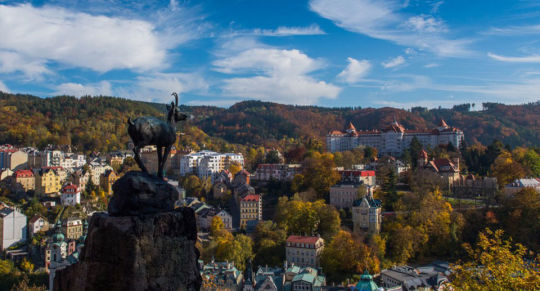
The cliff is decorated with a statue of a chamois, although during the hunt of King Charles 4 a deer rode along the steeps. The first to draw attention to the discrepancy (in the local forests there are chamois that easily climb rocks) Baron von Lutzov. He ordered a sculpture of an ungulate made of zinc on a hill. The author of the statue was August Kiss. The city council was indignant and tried to remove the chamois, but was late with the adoption of measures: the sculpture became popular.
She stood for 130 years, until she was barbarously destroyed. But a copy of bronze was installed at the site of the monument from zinc. The project was carried out by the sculptor Kotek. A gazebo is built on the crest for the convenience of exploring the surroundings. It is made with the money of the industrialist Mayer from Vienna. The arbor is preserved and bears the name of the founder: Gloriete Mayer.
Mlyn colonnade
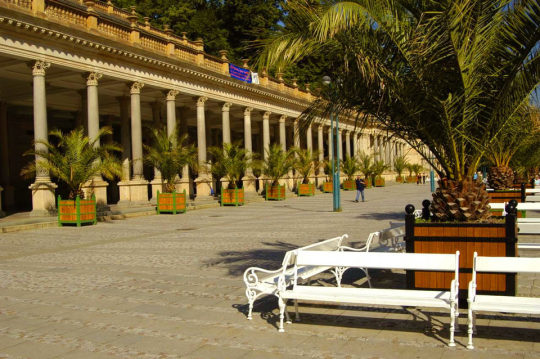
Today it is the most popular place in the city. Tourists are constantly gathering here. And this is not surprising: the air structure is supported by 124 graceful columns. It’s always cool inside, so guests take refuge here from the summer heat. And excellent acoustics contributes to the holding of concerts in the colonnade. A special orchestral pit is arranged for this. But there was a time when the townspeople were outraged by the appearance of the colonnade, they considered it to spoil the appearance of Karlovy Vary.
They spoke negatively about it, some even demanded to demolish such an ugly building. But tourists appreciated the unusual building: here you can listen to music for free (there are no walls completely covering the interior), wait out the heat. Inside there are as many as 5 sources of mineral water, from which it is offered to drink water around the clock.
It is noteworthy that all sources are located compactly, you can inspect them in a short time:
The rock spring was known for a long time: horses were bathed in warm healing water. Then the key was taken out of the rock, the territory was cleared of silt and dirt.
Libushi. He was named for the virtuous princess, whose descendants became kings.
Prince Wenceslas. In earlier times, the famous local salt was evaporated from its water. Now in the gallery of Wenceslas as much as 2.
Mlynsky. Since the 16th century, healing water has been sold in pharmacies of the city.
Mermaid. It was once the most popular and was called New.
Water in all sources is hot: its temperature is above 50 degrees Celsius.
Garden colonnade
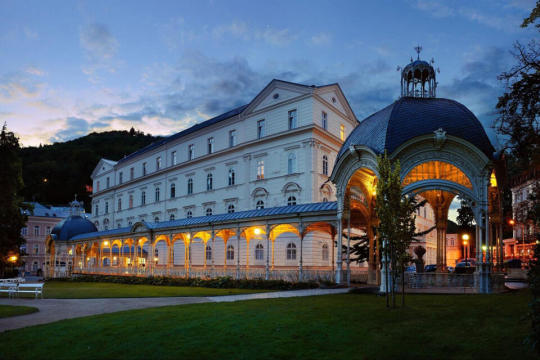
This openwork gallery is surely visited by all guests of the city. She is in the gardens, and her appearance is associated with the veneration of the Karlovy Vary of Antonin Dvorak. A bust of the composer is installed on the territory of the city garden. And nearby, the city authorities built a concert venue. The authors of the project were architects from Vienna Gelmer and Fellner. But after a short time the building was dismantled, leaving only a part. It was she who later became part of the colonnade.
In the colonnade, 3 sources come to the surface:
Garden (to release the key, I had to disassemble part of the wall of the military hospital),
Snake (decorated in the form of a bowl into which water flows from the mouth of a reptile),
Source of Freedom,
Surprisingly: in the Garden Colonnade the water is cooler than in other places, but it tastes better.
Market colonnade

The most permanent thing in life is temporary. The city colonnade was built by the city authorities to preserve the purity of unique mineral springs: Market and Karl 4. The city authorities ordered the project from the famous Austrians: Gelmer and Fellner. The architects used Swiss motifs: the pavilion turned out to be a copy of alpine arbors. Surprisingly, the bizarre structure organically complemented the urban development. It was assumed that the pavilion made of wood will stand for several years, and then it will be demolished or replaced with a permanent one. But the openwork gallery was so loved by the townspeople and tourists that they decided to leave it. Today, the building has its original appearance.
Guests can sample water from 3 sources:
Carla 4 (this is the oldest well in the region),
Market (water flowed irregularly from it, additional drilling required),
Lower Castle (key drainage from the Castle Colonnade)
The market pavilion is available to all visitors.
Castle colonnade
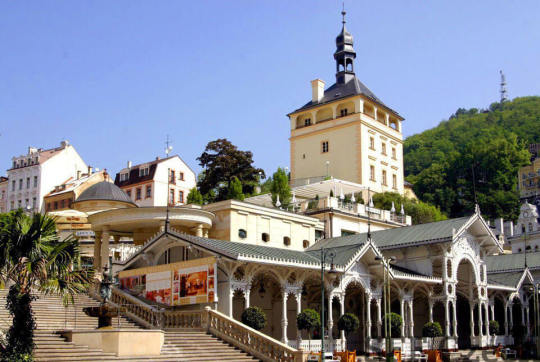
This is the youngest gallery in the region: it was built at the beginning of the twentieth century. The city ordered the project, and was completed by Johann Oman, an architect from Vienna. He decided that it was best to build a building in the Art Nouveau style: the most popular at that time. Until now, it has attracted guests with ease and grace. Historians of architecture do not remain indifferent to this building.
The keys of the pavilion are located above all others in the city: the flowing water has unique properties. The local hospital is extremely popular with guests of Karlovy Vary. And the place itself is amazingly picturesque: it is located on bare rocks. The gallery is decorated with a bas-relief made by Wenzel Heyda, the Spirit of sources. The architect used the mineral argonite.
But today, only those who are being treated in the health resort Zamkovy Lazne can drink water from the sources of the gallery: the administration of the center forbade tourists from entering the territory. You can see the pavilion of Oman from the Market Square. And one of the local keys is displayed in the Market Gallery: Lower Castle.
Geyser colonnade

The source Geyser is one of the symbols of the city. Mineral water deposit was discovered in the 16th century. Its power and allowed to build the first health resorts. A modern gallery was built only in 1975. Tourists are impressed by a stream of boiling water, soaring up by as much as 12 meters. This landmark and the main vases are inside a gray concrete building with huge glass windows. And in the square to attract visitors a small fountain has been organized, from which a low hot stream beats.
The water temperature in the Geyser is close to the boiling point, and the mineralization is quite high, so for convenience of consumption, already diluted ordinary mineral water is supplied to the vases. The temperature in different fountains ranges from 30 to 50 degrees Celsius. The degree of mineralization is sufficient for medicinal purposes.
A geyser is a powerful source. From it pipes were laid in all the sanatoriums of the city. The fluid flowing through them is used for medical and cosmetic procedures. And Geyser is a supplier of raw materials for the production of the famous salt. Guests wishing to explore the Geyser should note that the gallery is open only from 6 a.m. to 7 p.m. in winter, and in summer from 6 a.m. to 6 p.m.
Motorcycle Museum

You will have to take a ride to visit the exposition: the center is located in the village of Bečov nad Teploj. Visitors will see fifty restored motorcycles. Fans of bikes will get acquainted with original spare parts, which are no longer produced by factories, and accessories. The owners of the exhibition are proud that they used original parts when restoring old models.
Architecture lovers will love the building that houses the motorcycle exhibition: it was built in the 13th century. Nearby is a toy museum, an exhibition of weapons and firearms. And a walk in a quiet village itself will be a pleasure: narrow streets are imbued with the spirit of antiquity. The houses are clean and well maintained, there is even a castle.
Alois Klein’s Arbor

In the 18th century, a sour key scored in the territory that is now occupied by the Richmond Hotel. He was fenced and named for the Herz-Duchess: Stepan. Water began to be used in medical procedures. But in the 20th century, the key stopped beating. He was searched until 1993. In 1997, a vase was fenced with a gazebo made of wood. The architect Vondrachek turned to the tradition of alpine architecture: the structure turned out to be light and airy. And they called a gazebo by the name of the first owner of Richmond: Klein (Klein).
A gazebo stands in a picturesque park where centuries-old trees grow. The air is saturated with volatile. Walking to the source is enjoyable and rewarding. And you can drink an acidic mineral water at any time of the day, but it is important to remember: Stepanka does not have a certificate of registration of a natural healing resource.
Butterfly House

If the weather suddenly turns bad, you can spend time with benefit in the Butterfly House. Here, on the territory of an artificially arranged tropical forest, insects from all parts of the world are represented. Visitors immediately enter the flight zone, which occupies as much as 100 square meters. In it, motley beauties feel at ease, with a wingspan of up to 20 cm. Sometimes they sit on the shoulders or arms of tourists. The center is allowed to take pictures and shoot.
A separate area is reserved for the incubator: in it butterflies hatch from pupae. This is a spectacular sight. Along the path there are information boards with a description of the habits of the inhabitants of the pavilion. With luck, you can witness a romantic wedding ceremony. Some lovers specially for this come to Karlovy Vary. And at the reception souvenirs are sold. The house is open every day from 10 am to 5 pm (in high season – until 7). The administration of the center informs about the change in the work schedule in advance.
Church of St. Mary Magdalene

The church is conveniently located: near the Geyser. From the steps and now the gallery is visible. The modern temple is a fairly new building. And the first, founded by the Order of the Knights, appeared here in the 14th century. In the 16th century, the building was rebuilt, given the increased number of parishioners. But the church stood for a little over 100 years and died in a fire. In the 18th century, the townspeople again had to erect a completely new building on the old ashes. The work was complicated by the presence of a nearby source of powerful mineral water.
But it all ended happily: after 3 years, the first Mass was celebrated. And today the church of St. Mary Magdalene is amazing in magnificence. Inside, architects applied the wood carving technique. Presented and wooden painting. The ashes of the deceased, who rested in the old cemetery, were transferred to the crypt. Access is allowed for sightseers. You can inspect the interior of the cathedral at any time. During the visit, you must respect the feelings of believers. The cathedral hosts concerts of organ music. The schedule of events is posted on the temple’s information board.
Orthodox church of st. Peter and Paul

This temple is interesting in that it was built for Orthodox Russians who came to the resort of Carlsbad. The initiator was the Grand Duchess Elena Pavlovna, she also organized the initial fundraising. Donations were made by Shuvalov, Vorontsov, Koshelev. The city council allocated a place for development: a plot on Schlossberg Street. The project was ordered from the famous Russian architect Konstantin Ukhtomsky. But the money collected was not enough to start work, so the Carlsbad authorities allowed to build an Anglican church in a designated place. The Orthodox community was offered to buy part of the Grand Hotel Pupp. In several rooms a house church was built. But the community was growing, so they soon returned to the project of Konstantin Ukhtomsky. At this point, the board of trustees, chaired by the Russian Minister of Finance, had raised enough funds to build their own building. The work was carried out for 4 years: the consecration took place at the end of the 19th century. At the new church, the Turgenev Foundation was formed, and then the Russian House.
In 1914, the rector of the temple was arrested, and only the intervention of King Alphonse saved him from execution. And after the October coup, the servants of the Russian Orthodox Church escaped from the Bolsheviks in the priest’s house. Today, tourists can admire the quaint architecture of the cathedral. It recognizes the motives of Russian architecture of the 16th century. And inside the walls are decorated with magnificent frescoes depicting Basil the Great, John Chrysostom. The faces of locally revered saints are recognized: Vladislav and Lyudmila.
St. Anglican Church Bows
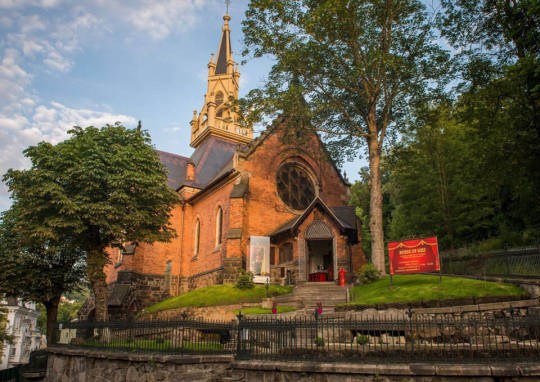
The cathedral is located in the very center of the spa town: on the slope of Castle Hill. The church is easily recognizable by the unplastered red walls that emphasize the origin of the building. Mists of Albion visited Carlsbad for relaxation and treatment. They spent several months at the resort, so it took them to build a church. The existing temple was small and could not accommodate all the parishioners, so it was demolished.
The new cathedral was designed by Carlsbad architect Joseph Slovak. The work was not carried out for long: about 2 years. The consecration of the temple took place at the end of the 19th century. Services in the cathedral were held until the beginning of the 20th century. Then the building was restored. By decision of the proprietor (Methodist Church), services ceased. But you can still see the interiors of the building: an exposition of wax figures is located in the church of St. Luke.
Visitors will not only see the unique exhibition of images of historical characters made at the Madame Tussauds in London, but they will also appreciate the original vaults of the building, carved ceilings and the original color stained glass windows of the 19th century.
City Theater

Already at the beginning of the 18th century, the Carlsbad authorities began to think about organizing leisure activities for vacationers. And for the entertainment of aristocrats built a theater of wood. But a big fire completely destroyed the building. Therefore, it was decided to build a permanent stone theater. The project was ordered from the Viennese architectural bureau Gelmer and Fellner. The work of architects demonstrated the ability to link buildings with existing buildings and landscape.
And today, tourists can appreciate the success of the builders: the city theater is the pearl of Karlovy Vary. The interiors of the building are impressive: there is hardly a curtain of paintings anywhere else. It consists of 8 paintings by artists. And the poet, surrounded by muses, is depicted on the curtain. Each of the girls inspires him to a special kind of creativity. The curtain was created by the brothers Klimt and Franz Match.
And the Klimt sisters served as models for the muses. The same artists painted the ceiling and walls of the auditorium. Separately, it should be said about the engineers: all the novelties of the 19th century were used in the hall. The acoustics turned out great. Today, the interiors (including the curtain) are completely renovated. And you can admire the wonderful design of the auditorium during the performance, which takes place in the theater regularly.
Villa Luttsov

Baron von Lutzov first visited Carlsbad as a rather elderly man: he was 50 years old. Purpose common: water treatment. But von Luttsov liked the city so much that he decided to settle here permanently. The rich man liked to settle in comfort: a day from the sale of property in his homeland he built a luxurious villa. The park is especially noteworthy: terraces, boardwalks, arbors and pavilions were fantastically combined here. On the territory there are sculptures of animals: bull, cat, deer, dogs and horse.
Particularly noteworthy is the image of a cat. Von Lutzov was in constant confrontation with the city council. The sarcastic baron commented on the administration’s strange (in his opinion) decisions. After the statue of King Charles 4 was installed in the central park, a cat appeared on the territory of the villa, sitting on a huge pedestal back to the city council building. I must say that the sculpture of the monarch in the park stood on a powerful pillar.
The disrespectful cat in her pose said to the townspeople:
less attention is paid to the king than to the foundation of the monument,
the monument itself is interesting exclusively to local authorities,
sculptor – complete mediocrity,
von Lyuttsov is indignant at this interpretation of the merits of the king
Unfortunately, walking along the paths of the villa and seeing the legendary cat today is unlikely to succeed: the new owners have closed access to tourists on the territory. But you can look at part of the park because of the fence from the street.
Castle tower

The tower is located in the historical center of the resort: it offers a wonderful view of the Castle and Market Colonnades, and the famous Geyser is within easy reach. This is a fairly new building. It was erected in place of the old one left from the castle of King Charles 4. In place of a hunting lodge in the forest, the monarch ordered the construction of the castle. But in 1604, a strong fire completely destroyed the building. One tower remained intact. But the preferences of the townspeople changed, the Baroque style came into fashion.
The surviving tower was demolished, and a new one was erected on its foundation. Immediately, a tradition arose: to meet eminent visitors to the town with fanfares that were heard from the Castle Tower. Some particularly respected people are welcomed today. The tower has an excellent restaurant serving national Czech cuisine. It serves excellent meat cooked according to old recipes and local cheese. It’s nice that the prices in the institution are quite affordable.
Orthodox chapel of st. Nikolay
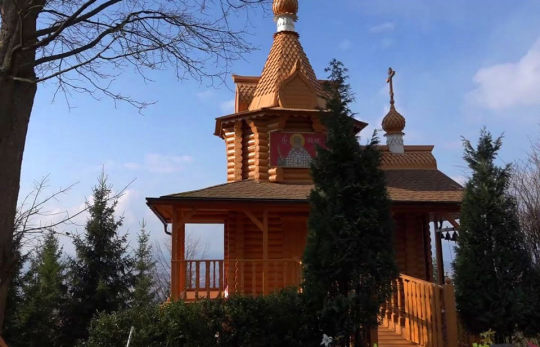
A native of Russia, Nikolai Stepanov, built his own chapel on his own money. The project shows the traditions of Russian wooden architecture. The chapel was assembled on the spot (in Russia), then the frame was numbered and sent to Karlovy Vary. A reassembly took place on Doub Mountain. In November 2000, Archbishop Christopher consecrated the chapel. But the services did not take place for long: today the chapel is closed for believers. But the Douba Mountain offers wonderful views of the surroundings, and the wooden openwork building blends in seamlessly with the local landscape. Tourists still come here.
Jan Becher Museum

Patients from all over Europe came to Carlsbad for healing with healing waters. And everything in the city was done so that the treatment was successful, and rest was remembered for a long time. And when the tincture of herbs for alcohol began to be sold in the Bechera pharmacy, it did not surprise anyone.
But very guests of the resort appreciated the wonderful taste, and the healing drug became popular in all countries. The name of the drink was named after the author: Becherovka. More than 200 years have passed since that time, and everyone still likes liquor: every tourist brings a bottle of Becherovka branded souvenir.
The popularity of the drink pushed the successors of Jan Becher to create a museum. Here are presented:
branded packaging (bottles, jars, beakers and cardboard boxes) used for liquor in different years,
manufacturer logo labels,
branded tableware (glasses, beakers, glasses),
liquor advertisement,
fake samples of a popular drink
Visitors will be shown a cellar where a wonderful liquor is prepared, they will also be told about how Jan Becher came up with a recipe. Demonstrate linen bags with secret ingredients. Most components are assembled in the county, but some have to be imported. But no one will ever divulge a secret recipe: brand owners carefully guard it.
Incredibly, a few people know the exact list and number of elements. And the event ends with a tasting of amazing Becherovka. You can buy a drink as a keepsake and as a gift to friends in a company store located nearby. You can visit the museum daily from 9 am to 5 pm.
Museum of glass “Moser”
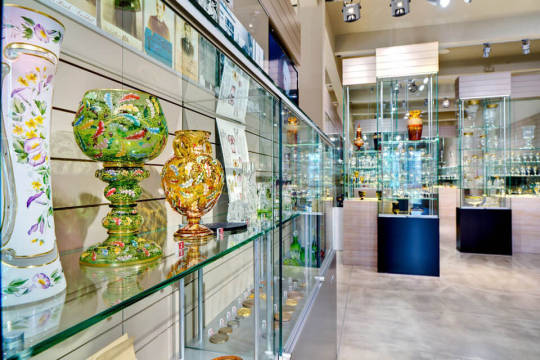
150 years ago in Europe, every royal court had dishes made at the factory of Ludwig Moser. And despite the high price, noble families tried to acquire beautiful and fashionable sets of the famous manufacturer. And today, Moser’s products are popular. Tourists who come to Karlovy Vary, strive not only to buy a souvenir from colored glass as a keepsake or as a gift, but also to visit the exposition.
Visitors to the exhibition will see:
types of colored glass products manufactured at the factory for 150 years,
antique gizmos, once mass-produced, but now available in single copies,
modern and fashionable product designs
In total, more than 1000 units of storage are exhibited in the halls of the plant. But that is not all. Guests can visit the glass-blowing workshop, where they will be introduced to:
with samples of raw materials,
types of glass melt,
the process of transforming an undefined source material into an elegant glass product,
tools and technologies used for different types of products
But the final stage of production (final design of products) remains behind the scenes. But visitors have the opportunity to visit a branded product store, which is also very interesting. Here you can not only buy your favorite glass product, but also make engraving on it if you wish. Tired and hungry sightseers will enjoy lunch at the Moser signature cafe, from the terrace of which an amazing panorama of Ludwig Moser Square opens in the summer.
An unusual fountain is built on it, which is surrounded by crystal figures produced at the Moser factory. The museum is open for visitors during the week from 9 am to 5 pm. But excursions to the glass-blowing shop are made from 9 a.m. to half-past three in the afternoon. Shop and cafe stop working at 6 pm.
#Moser#Deer Jump#Diana#Alois Klein's Arbor#Butterfly House#Castle colonnade#Castle tower#Church of St. Mary Magdalene#City Theater#Garden colonnade#Geyser colonnade#Jan Becher Museum#Market colonnade#Mlyn colonnade#Motorcycle Museum#Museum of glass#Observation Deck#Observation Deck Three Crosses#Observation tower#Orthodox chapel of st. Nikolay#Orthodox church of st. Peter and Paul#St. Anglican Church Bows#Villa Luttsov
0 notes
Photo

New Post has been published on https://vacationsoup.com/things-to-do-in-the-smoky-mountains/
Things To Do In The Smoky Mountains
20 Fab Things To Do In The Smoky Mountains - Our helpful video guide
The Great Smoky Mountains are a part of the famous Appalachian Mountains, which run down most of the Eastern Coast of the United States. These mountains set the border between Tenessee and North Carolina, and are mostly the home of Great Smoky Mountain National Park.
In this vast region, visitors will find a myriad of activities, from outdoor hiking trails up the mountains and underneath the waterfalls, to experiencing firsthand what passengers on the infamous Titanic felt at the Titanic Museum in Pigeon Forge in Tennessee. The Smoky Mountains is the perfect place for viewing nature, with stunning caverns and rocky mountain peaks as well as a ton of old and rustic log cabins and barns hidden away into the wilderness, as a treat for history buffs.
youtube
Free Things to Do in Smoky Mountains
1. Cade's Cove
Cade’s Cove is a frequented spot in Great Smoky Mountain National Park, accessible via a loop road that surrounds the area. This stunning valley is circled by the high mountains of the Great Smokies and provides some gorgeous views for visitors, who often see wildlife such as turkeys, deer, coyotes, black bears while they are sightseeing.
The road to Cade’s Cove is open to vehicles, and along the drive visitors may spot old churches, mills, barns, and houses from the 18th and 19th centuries. Hikers will enjoy the hike to Abrams Falls or Thunderhead Mountain, or a short jog along the Cades Cove Nature Trail.
youtube
Cool Things to Do in The Smoky Mountains
2. Cataloochee Ski Area
The Cataloochee Ski Area is situated in the southwest area of North Carolina, with a total of eighteen slopes and trails for snowboarders and skiers of varying abilities. Cataloochee Ski Area also has regions for snow tubing and offers lessons for beginners and kids all season long.
Guests can avail of day passes or season passes for the ski area, and lodging is offered there, too. A lot of the slopes are outfitted with lights so that skiers can safely continue their activities into the dark evenings of the winter, and all are rated and marked by a level of difficulty.
youtube
Stunning Views to See in The Smoky Mountains
3. Chimney Tops Trail
The Chimney Tops Trail is one of the most frequented trails by hikers inside the park, and even though the going is tough, the picturesque views at the end make it all worth it.
A trip from the trailhead and back again is only about 4 miles, but the elevation gain on the 2-mile trek out is an estimated 1,400 feet, with a steep climb over rocks that can get quite slick in wet or icy weather. The hiking path extends over rocky terrain, flowing streams, and switchbacks along the slopes before reaching the rocky top known as the Chimney, where hikers will be treated with stunning views.
youtube
One of a Kind Things to See in Smoky Mountains
4. Clingman's Dome
Clingman’s Dome is situated in the Great Smoky Mountains National Park and is the peak point in the state of Tennessee. This towering mountain reaches up to 6,643 feet at its summit, which is accessible via a paved trail that directs to the observation tower at the top.
Visitors can see breathtaking 360-degree views of the park and the nearby mountains, which on a clear day can stretch for more than100 miles. The concrete trail is half a mile long and rather steep, and temperatures at the top can be quite cold. The observation tower can be reached via the Appalachian Trail.
youtube
Things to Do with the Family in Smoky Mountains
5. Dollywood's Splash Country
Situated in Pigeon Forge, Tennessee, both Dollywood and Dollywood’s Splash Country are waterparks owned by the one and only Ms. Dolly Parton. At Dollywood’s Splash Country, guests can have a thrill racing down waterslides, getting soaked at the Bear Mountain Fire Tower, or plunging through dark caverns and meandering turns on the Big Bear Plunge.
The waterpark is home to about 35 acres of slides, water attractions, and pools, with areas for picnicking, dining, and relaxing for a whole day of fun and water games. Dollywood's Splash Country is open during the warmer months, and opening hours depend on the weather.
youtube
VISIT THE WEBSITE FOR MORE DETAILS
Scary Things to See and Do in Smoky Mountains
6. Elkmont Ghost Town
Tucked somewhere along the Little River Trail in the Great Smoky Mountains lies Elkmont, an old abandoned town where old buildings have lain to rot for decades. Once renowned as "the Appalachian Club" early in the 20th century, Elkmont played a major part in the creation of Great Smoky Mountains National Park itself.
The citizens of this town sold their property to the government for a lifetime lease, and a lot of those leases expired in the 90s and early 2000s, leaving all of the houses and buildings empty. Today, Elkmont Ghost Town stands as an eerie reminder of the past, and even though most of the structures are lined up for removal, guests in the area now can see something truly one of a kind.
youtube
Extraordinary Things to See in the Smoky Mountains
7. Forbidden Caverns
The Forbidden Caverns, underneath the English Mountain in the eastern part of the Great Smoky Mountain, are not so forbidden like the name suggests. Numbered among more than 8,000 caves in Tennessee, the Forbidden Caves are open for people who want to see the stunning underground caves lit up with colorful and eerie lights.
Over the years, these caverns have been used as a shield from extreme weather, as the site of illegal moonshine stills during Prohibition, and now as a famous tourist attraction. Forbidden Caves houses some beautiful rock formations, quiet pools of water, a cold, clear stream, and a huge wall of cave onyx.
youtube
Free Things to See in Smoky Mountains
8. Great Smoky Mountain National Park
Great Smoky Mountain National Park is situated along the border between North Carolina and Tennessee and is the most famous national park in the US. Covering over 800 square miles of forest, rocky ridges, mountains, rivers, and more, Great Smoky Mountain National Park is popular for the diversity of nature found within it.
Visitors can drive, hike, and explore the park to reach the peaks of mountains, awe at the gorgeous waterfalls, or learn a bit about history from the structures on the property. Great Smoky Mountain National Park is gorgeous in any season and houses many spectacular spots for hiking, horseback riding, or biking including the Charlies Bunion, Alum Cave Bluffs, and Rainbow Falls.
youtube
Refreshing Things to See in Smoky Mountains
9. Grotto Falls
Grotto Falls is reachable via the Trillium Gap Trail, the start of which is located on the Roaring Fork Motor Nature Trail. On the almost 3-mile round trip, which is of moderate difficulty, hikers will hike through old hemlock forests in a tranquil atmosphere until they reach the falls.
The hiking trail leads directly behind the cascading water of Grotto Falls, providing a unique and stunning point of view for visitors, and the 25-foot-tall waterfall is a refreshingly cool and beautiful destination. For everyone’s safety, though, climbing on the rocks along the waterfall is forbidden as these rocks can get incredibly slimy and slippery.
youtube
Scenic Things to See in Smoky Mountains
10. Little River Road
Little River Road, situated between Gatlinburg and Townsend in Tennessee, provides a relaxing and picturesque drive along the Little River. More than 18 miles, Little River Road has a lot of overlooking sights and picnic areas, and is an awesome way to reach some trailheads like Laurel Falls or Cades Cove, where the road ends.
Seven signposted areas are along the road to direct points of interest for drivers, including waterfalls, trailheads, and picnic areas. This gorgeous drive is a great way to take in some lovely view, go for a picnic, or begin a wonderful hike.
youtube
Cultural Things to See in Smoky Mountains
11. Mountain Farm Museum
The Mountain Farm Museum celebrates some of the homes and buildings built by pioneers during the early 19th century. A lot of the structures were relocated to the museum during the 1950s, but the barn, built sometime in 1880, still stands on its original location.
The alfresco museum includes an old rustic log cabin constructed in around 1900, an icehouse utilized for refrigeration, a blacksmith shop, and two corn cribs, among other things. At the farm, guests can explore the buildings and learn about each of their individual stories for a glimpse at life and culture on a 19th-century farm in the mountains.
youtube
Historical Things to See in Smoky Mountains
12. Oconaluftee Indian Village
Cherokee, North Carolina, is a town situated in the Eastern Cherokee Reservation. Within the town is the Oconaluftee Indian Village, where visitors will be brought back to the 18th century to see life as the Cherokee tribe once lived it.
With the help of a tour guide, guests will follow through the paths of the village across dwellings, ritual areas, and more while learning more about the traditions and culture of the Cherokee tribe. Guests can watch traditional dances, see villagers engage in age-old crafts such as basket weaving and canoe-making, and witness an actual blowgun demonstration.
The Oconaluftee Indian Village is open Mondays through Saturdays from April until November.
youtube
Thrilling Things to Do in Smoky Mountains
13. Ramsey Cascades
Great Smoky Mountains National Park is full of stunning cascading waterfalls, the tallest of which is Ramsey Cascades, which has a drop of more than 100 feet.
The waterfall is reachable via a hike along the Ramsay Cascades Trail, which starts atg the Greenbrier area and stretches for about 4 miles each way. On the hike, the elevation level increases by more than 2,000 feet, over rivers and through forests along a tough trail that is recommended for seasoned hikers in good physical condition only.
All the difficulty is rewarded, though, in the end by the panoramic view of the falls, which pool at the bottom full of huge rocks and salamanders.
youtube
Incredible Things to See in Smoky Mountains
14. Ripley's Aquarium of the Smokies
Ripley’s Aquarium of the Smokies was recognized as the Best Aquarium in the US by USA Today, and it’s pretty easy to see why. With everything from stingrays, to penguins, to sharks, Ripley’s Aquarium of the Smokies offers a diverse array of aquatic life for guests to enjoy, and its educational, lively, and fun live shows are the perfect way for guests to learn about marine biology and enjoy some incredible sights.
In the aquarium, guests can clearly see 12-foot-long sharks through the glass bottom of a boat, make a masterpiece with the help of an African penguin, or watch energetic mermaids in an underwater show.
youtube
Things to See with the Kids in Smoky Mountains
15. Seven Islands State Birding Park
Seven Islands State Birding Park is situated just a quick drive from Knoxville and houses more than 200 unique species of birds.
Seven Islands State Birding Park is located on a peninsula along the French Broad River, and inside the park are over 8 miles of trails where visitors can relax, hike, and observe diverse variety wildlife and beautiful sceneries of the mountains.
Guests can explore the trails, kayak on the river, and try to spot the birds of prey, songbirds, and barn owls who frequent the area and live in the park.
youtube
Things to Do with the Kids in Smoky Mountains
16. Smoky Mountain Alpine Coaster
With a track that is more than a mile long, the Smoky Mountain Alpine Coaster is the longest of its kind in the United States.
Guests will hop into a sled, which can carry up to two passengers and advances downhill on a picturesque and fast-paced track across the Smoky Mountains and the nearby areas. The passengers can control the speed of their own sleds, which can move up to about 30 mph through twists, slopes, and turns for an unforgettable experience.
The Smoky Mountain Alpine Coaster is open all year long, in sun, rain, or snow.
PRICES, OPENING HOURS AND MORE INFORMATION
youtube
Educational Things to Do with the Family in Smoky Mountain
17. Smoky Mountain Deer Farm and Exotic Petting Zoo
Smoky Mountain Deer Farm is a fun and educational family-friendly destination that lets visitors get up close with not only deer, but also animals like zebras, camels, otters, and even reindeer among many more. At Smoky Mountain Deer Farm, visitors can learn about many various species of exotic animals while getting a face-to-face experience.
The zoo also houses Deer Farm Riding Stables, where visitors, especially kids, can take a riding lesson or a pony ride, or lead out on a guided trail that will offer them with some pretty stellar views of the Smoky Mountains.
youtube
Iconic Things to See in Smoky Mountains
18. Titanic Museum
The Titanic Museum in Tennessee is a one-of-a-kind experience that tells the story of the iconic doomed ocean liner and the lives that were lost on that unfortunate night in 1912.
Inside the museum, guests can get a glimpse of what it was like to explore the corridors and cabins of the great ship, with more than 400 artifacts on exhibit from the wreck and the passengers.
Titanic Museum offers guests the chance to feel firsthand the icy waters of the Atlantic that fateful night, touch an actual iceberg, and try to keep their footing on slippery decks that slant upward at the angle of the sinking ship in an experience that you can get nowhere else.
SEE THEIR WEBSITE FOR MORE DETAILS
youtube
Gastronomic Things to Do in Smoky Mountains
19. Dine at Huck Finn’s
Huck Finn’s is a family-ran and operated restaurant in the heart of Pigeon Forge. They take pride in serving delicious food—especially amazing catfish, great prices, and wonderful service. If catfish is what you crave, you can enjoy all you can eat at Huck Finn’s.
Their eat all you can catfish and chicken is world famous. Just search for the hashtag #HereIsHuck on Instagram! They also offer a southern menu with country fried steak, frog legs, grilled chicken, shrimp and a lot more! Each meal is kicked off with unlimited ‘vittles.’ which is coleslaw, french fries or mashed potatoes, white beans, , hushpuppies, onion slices, and dill pickles.
youtube
Unique Things to See in Smoky Mountains
20. Tuckaleechee Caverns
The stalagmites and stalactites of the Tuckaleechee Caverns are situated in Townsend, Tennessee. They are over 20 million years old, with a cold and clear underground stream that runs through the wide chambers and the Big Room, which is over 400 feet across, with stalagmites that reach up to 24 feet tall.
There are over 8,000 caves in Tennessee, but the Tuckaleechee Caverns are the best rated of their kind in the eastern US. Visitors of the caverns can marvel at the Big Room as well as a double waterfall – Silver Falls – which has an almost 200-foot drop, on a mile-long guided tour of the caverns.
youtube
0 notes
Photo

The Lavender Federation trail is a linear walking trail that begins its journey on the banks of the Murray River in Murray Bridge, SA. For 325 km it winds its way northward towards the Clare Valley ending in the town of Clare. You find yourself walking amongst some spectacular countryside, through fields of canola, and green paddocks with the company of sheep, cows and even kangaroos.
On this trail, you’ll be serenaded by the sounds of the birds, you’ll dodge a few wombat holes, be greeted by a myriad of wildlife and share a rock with the odd lizard or two. You stroll along country dirt roads, up rocky outcrops and a wander through the famous Barossa Valley Region.
You’ll wander through bright yellow fields of Canola on this walk.
There is so much to see and unusual sights as well such as some very long necks reaching high into the treetops! Yes, giraffes along with the odd lion, zebra or even a rhino! This is because, through Rocky Gully, you pass by Monarto – one of the world’s largest open-range zoos.
I found walking in the Australian countryside and happening upon this sight unusual, but a real treat.
Flocks of sheep will keep you company on this journey.
History of the trail
This trail is named in the honour of the late ‘Mr. Bushwalking’, Terry Lavender. He was the architect for the trail and is a man who is also remembered for his part in the creation of the famous Heysen Trail.
In the late 1990’s it was realised that the eastern side of the Mt. Lofty Ranges in South Australia offered a great location for a long distance walking trail with the ranges protecting the trail from harsh weather for most of the year. It was designed, built and is now maintained by a team of volunteers.
The trail is maintained by a group of dedicated volunteers.
The trail has many varieties of link and loop sections to explore and it connects to other trails including the Heysen and the Riesling trails. You also pass through townships including Murray Bridge, Tungkillo, Eudunda, Mintaro and Clare.
There is so much history to be found on this trail and in the towns you enter. Much of it goes back to the early 1800s and is well worth researching beforehand to find out more as you wander along. When you come across the town of Springton a must visit is the historical Herbig Tree. Friedrich and Caroline Herbig lived in this hollowed out River Red Gum tree (which is 300-500 years old) back in 1855 with the first 2 of their 16 children.
The towns you pass through are steeped in history.
Length
This trail is 325 km in length with an extra 100km of loops and spur trails to explore.
Trail markers
You will find this trail to be very well marked with reflective silver and green plaques with an arrow pointing the way. They are on posts, fences and even rocks. Although the trail is well marked it is recommended that you purchase and carry the maps for the trail.
Look out for the trail markers that are posted along the way.
Navigation – maps and guidebooks
With 6 maps in total, these can be purchased at many outlets including the Lavender Federation Trail website, Murray Bridge Visitors Centre and Clare Visitors Centre. The maps contain great information including the trail length and terrain, historical information of the area and more.
Even though the Lavender Federation trail is well marked, it’s recommended to use a map.
What’s the best time of the year to hike it?
It is recommended to walk this trail between the months of March and November. Remember Summer in Australia can be extremely hot and there is always a high risk of fire. Walking is not permitted on days of total fire bans.
Terrain
The terrain is varied and for the most part a comfortable walk with a few steeper and rocky sections. You will be travelling through many private farmlands and old dirt country roads.
It’s a comfortable walk with some steep and rocky areas.
Accommodation
Camping is strictly prohibited at any point along the Lavender Trail, so you have to plan your accommodation ahead of time. The Lavender Federation Trail website has a full list of available places to stay along the route which you should check out.
What fitness level do I need?
You would need to have a relatively good level of walking fitness for this trail.
If you want to walk this trail, you will need to be in good shape. Image: Graham Hallandal
Gear to take
Backpack
PLB
Maps and compass
snake bite kit
Hydration system and a LifeStraw (for emergencies)
Wet weather gear
Hiking poles
Head buff and
Mosquito net (for when the flies get bad)
Sit-a-pon (waterproof mat to sit on when you have a break)
Flask (to carry your coffee for your break time)
Change of clothes, spare shoes and socks (for when in town)
for your daily lunches
Water and food along the way
Be sure to fill up on water at the beginning of each day before leaving town as there are no resupply points along the way. It is recommended that you carry up to 3 litres each day. Carry the snacks and lunch you need for your days walk as there is nowhere along the way to purchase any food.
Take your food with you for each day so you can stop for lunch.
Safety and communication on the trail
It is important to always remember your safety is your responsibility. There is phone reception on some parts of the trail but it’s unreliable so have plans in place before heading out each day. You want to have an experience that you want to remember, not regret.
Tell people of your whereabouts and intended time of return
Give a loved one your itinerary and contact them when you return
Carry a PLB with you and place it where you can reach if needed, not inside your backpack
Get the Australia wide Emergency Plus App
Carry up to date maps as trails do change from time to time
Always stay up to date with weather alerts and conditions
Be aware of drivers on the country dirt roads, they may not see you
Carry a first aid kit and snake bite kit and know how to use them
Carry at least 3 litres of water per day
Wear appropriate clothing for your hike
In the case of a wildfire, stay calm, alert authorities of your whereabouts and try to head to an open area
Be safe when walking this trail, as some parts have no phone reception.
Useful information
The Lavender Federation Trail website
Emergency Plus App
Police assistance 131 444
For an emergency call 000 or 112 from mobile phones
Check the BOM weather app for alerts
How do I get to the trail?
If starting in Murray Bridge it is a 50 min drive from Adelaide city. There are daily buses leaving the city throughout the day which takes around 2 hours. You can find more information on this at LinkSA.
If starting from the Clare Valley it is a 90 min drive from Adelaide or you can take a coach line with the York Peninsula Coach Lines. This service runs Monday, Wednesday and Fridays and weekends.
I decided to walk this trail by myself, and all up it took 9 days to finish it.
My walk
Back in 2015 I discovered this trail whilst researching another and decided it was worth exploring. At the time, the trail only went as far as Eudunda, (now it reaches Clare) and no one had ever walked it continuously before. As I’m from interstate, I decided that I would walk it in one go and it took 9 days to complete. It was an amazing experience to walk solo through rural South Australia and you can read more about my walk here. I hope to head back and walk the whole trail again in the very near future up to Clare.
I would like to acknowledge that this beautiful walk would not be possible without the hard work and dedication of the Lavender Federation Trail Community. For anyone planning to take on this trail, I strongly advise you to contact them in advance to ensure the best experience possible.
What’s your favourite South Australian hike?
The post Guide to Walking the Lavender Federation Trail appeared first on Snowys Blog.
#>First#/specFilters=5m!-!2163&pageSize=40&orderBy=-1&pageNumber=1#>insect#/specFilters=5!-!1771&pageSize=40&orderBy=10&pageNumber=1#/specFilters=5m!-!2090&pageSize=40&orderBy=-1&pageNumber=1>sun#/specFilters=5m!-!2459&pageSize=40&orderBy=-1&pageNumber=1>Battery#/specFilters=5!-!1924&manFilters=212&pageSize=40&orderBy=-1&pageNumber=1">Lunch
0 notes
Text
20 Things to See and Do in Bogotá
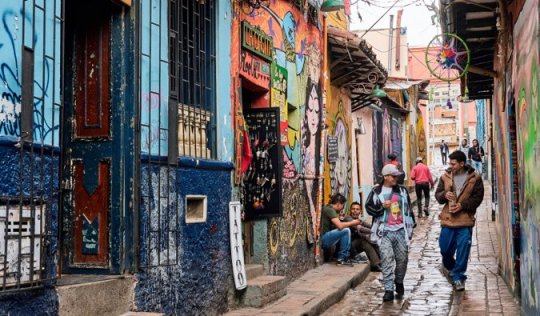
Posted: 03/25/2019 | March 25th, 2019
The capital of Colombia, Bogotá was the home to the region’s indigenous people, the Muisca, when the Spanish came around plundering gold and resources, and it’s been the country’s main city ever since.
Before I went, everyone told me Bogotá wasn’t anything special: dirty, crowded, hard to get around, and lacking the charm of the other big cities in Colombia.
“Spend a few days there and move on,” they all said.
Well, I spent a few days there — and then a few more.
I LOVED Bogotá.
It felt like the most “Colombian” city I visited. It’s not like the gringofied cities in the rest of the country. Its “gritty” nature was what appealed to me.
Bogotá was a vibrant, lively city I couldn’t get enough of.
The museum scene is incredible, there’s a lot of history, a blossoming art community, an exciting food scene, a wild nightlife, and super welcoming people.
It is also a huge city with a ton of tours, day trips, and other things to do. You could easily spend a week here.
To help you make the most out of your visit, here are my top 20 things to see and do in Bogotá.
20 Things to See and Do in Bogotá
1. Take a Free Walking Tour

One of my favorite things to do when I get to a new destination is to take a free walking tour. It’s a great way to get the lay of the land, see the main sights, and have a local expert answer any and all of my questions.
BeyondColombia has a great free walking tour that will give you a solid introduction to the city. It also has a free food tour, which is a terrific way to get a taste of some local Colombian dishes (you’ll spend around 18,000 COP/$6 USD on food for the tour). Just be sure to tip your guides!
For a more specialized tour, check out the Bogotá Graffiti Tour. This one operates by donation, using the money raised to reinvest in future community art projects.
2. Stroll in the Botanical Gardens
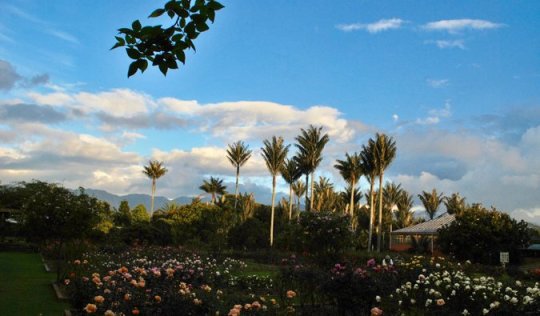
Opened in 1955, the Botanical Garden of Bogotá is home to almost 20,000 plants. There is a focus on regional plants, usually those that are endemic to the Andes and other high-alpine regions of the continent. It’s a really peaceful place to walk around, and there are some food stalls nearby, so you can grab a quick bite as you explore the gardens and browse the exotic flowers and trees.
Cl. 63 No. 6895, +57 1-437-7060, jbb.gov.co. Open daily 8am-5pm (9am-5pm on weekends). Admission is 3,500 COP for adults and 1,800 COP for children.
3. Climb Monserrate
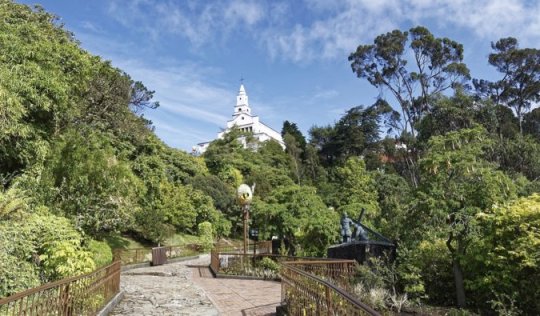
Standing tall at over 3,000 meters, you can see Monserrate from pretty much everywhere in town. It’s a popular spot to take in the view, and since there is a church at the summit, it’s also a popular spot for local weddings. You can walk up yourself in under an hour, or you can take a cable car or funicular to the top. Keep in mind that the walk up isn’t that safe at night or alone — thieves scout out the route. Be careful!
The funicular runs Monday-Saturday 6:30am-11:30am and Sundays 5:30am-4:30pm. The cable car is available Monday-Saturday 12pm-11:30pm and Sundays 10am-4:30pm. Tickets for either vehicle are the same price: round-trip tickets cost 21,000 COP for adults (12,000 COP on Sundays).
4. Visit the Museo del Oro (The Gold Museum)

This is the most interesting museum in the entire country and sees over half a million tourists every year. Opened in 1939, the Gold Museum documents the importance and use of gold in pre-Hispanic civilizations in Colombia and is home to over 55,000 gold items. There’s a lot of information to take in, so be sure to get the audio guide (8,000 COP) or join one of the daily free tours.
Cra. 6 No. 15-88, +57 1-343-2222, banrepcultural.org/bogota/museo-del-oro. Open Tuesday-Saturday 9am-6pm and Sundays 10am-4pm. Admission is 4,000 COP for adults and free for children. Admission is also free for adults on Sundays, but it gets busy quickly so be sure to arrive early!
5. See the Salt Cathedral
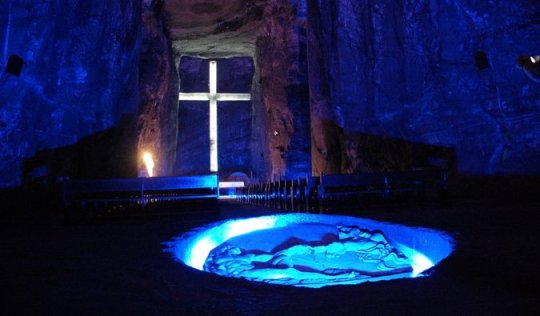
Located about an hour’s drive from the city in Zipaquirá, the Salt Cathedral is a Roman Catholic church that was built in the tunnels of an old salt mine. It’s 200 meters below ground, making this one of the more unique religious sites in the country, if not the world. Every Sunday, up to 3,000 people attend church services here.
Parque de la Sal, +57 315-760-7376, catedraldesal.gov.co. Open daily 9am-5:40pm. Admission is 58,000 COP for foreigners, with discounts available for seniors.
6. Check out the Museo de Botero

Founded in 2000, this museum is home to one of Latin America’s most important art collections. The museum was created after Fernando Botero donated hundreds of his works to the Banco de la República de Colombia with the promise that they would be displayed in a free museum for everyone to see. In addition to his own pieces, included in the donation were works by Monet, Picasso, and other world-famous artists. Take a free tour or get the audio guide (not free).
Cl. 11 No. 4-41, +57 1-343-1316, banrepcultural.org/bogota/museo-botero. Open Monday and Wednesday-Saturday 9am-7pm and Sundays 10am-5pm (closed Tuesdays). Admission is free, and free guided tours are available daily; see the website for updated times. Audio guides are available for 10,000 COP.
7. Explore La Candelaria

I really loved this neighborhood. This is the old part of Bogotá. You can wander the narrow cobblestone streets and take in the eclectic architecture, with art deco, colonial, and baroque styles all calling the neighborhood home. Many of the city’s best attractions (also, many hostels) are here too, such as the Botero Museum, the Gold Museum, and several churches and universities. Watch live music while hanging at Plaza Chorro de Quevedo, try the local chicha (a drink made from corn, often fermented to be alcoholic) on the side streets, and take in some of the amazing restaurants in this district.
8. See the Santuario Nuestra Señora del Carmen
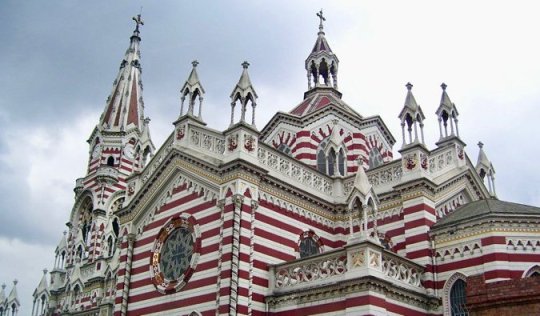
The National Shrine of Our Lady of Carmen is a Gothic church located in La Candelaria. The church has a red-and-white striped pattern — both on the outside and inside — making it look like a giant candy cane. Built from 1926 to 1938, the church stands almost 60 meters tall has some incredible Byzantine and Moorish art.
Cra. 5 No. 8-36, +57 1-342-0972. Open Monday-Friday 7am-7:30am and 10am-4pm, Saturdays 7am-7:30am, and Sundays 7am-12:30pm.
9. Visit Simon Bolívar Metropolitan Park

This is one of the most popular parks in Bogotá. Created in 1979, it spans almost 1,000 acres. You can find people exercising, relaxing, or attending concerts here. The park is named after the famous Simón Bolívar, who led the liberation of the region from its Spanish overlords.
Open daily 6am-6pm. Admission is free unless there is a concert or event in progress.
10. Wander Plaza Bolívar
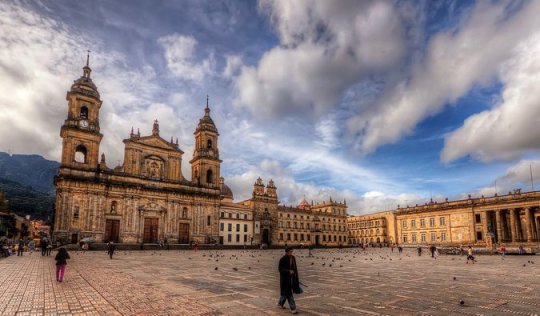
This is the main square of Bogotá, home to Colombia’s Palace of Justice, the Cathedral of Bogotá, the mayor’s office, and the Capitol Building. It’s the historical heart of the city, with buildings from as early as the 16th century. Under the Spanish, the plaza was home to bullfights, circus acts, and public markets. Watch out for the plethora of pigeons!
11. Head to the Laguna de Guatavita (Lake Guatavita)
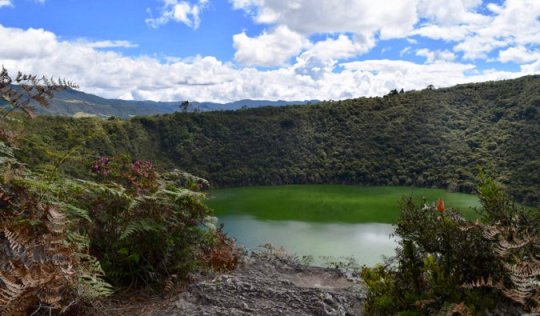
If you want to take a break from the city and get some fresh air, head out on a day trip to Lake Guatavita. Located around 60 kilometers north of Bogotá, this small lake is a sacred site to the region’s indigenous people and is apparently where the rumors of El Dorado originated. There are also hot springs in the nearby town of Sesquilé if you’re in need of some relaxation.
Day trips to the area last around 6 hours and will vary in price. Expect to pay at least 180,000 COP per person.
12. Explore Parque 93
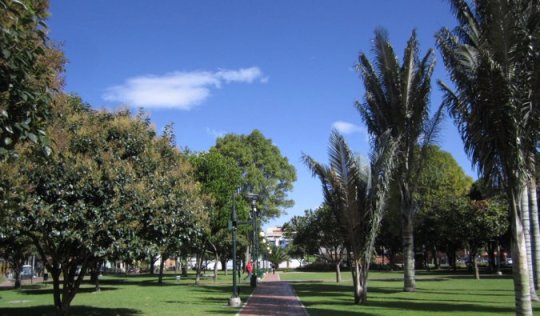
This is the area of town with some of the best restaurants, nightclubs, and bars in the entire city. The park itself is home to an ongoing rotation of temporary art exhibitions. Located in one of the nicer areas of town, you’ll find a lot of good restaurants and cafés lining the park.
13. Attend Gringo Tuesdays

This is a weekly language exchange that evolves into an international party. Every Tuesday, you can meet with other locals and travelers for a few hours of conversation. Once that’s over, the real party begins and goes late into the night. It’s a fun, social night out if you’re looking meet fellow travelers. A lot of hostels organize party buses to the event, so if you’re coming from La Candelaria, this is a good transportation option.
Street 85 No. 11-53, Promenade del Faro, +57 311-492-0249, gringotuesdays.com/en. Every Tuesday, the language exchange occurs 4pm-8pm, followed by the party, which runs 8pm-3am.
14. Discover the National Museum of Colombia
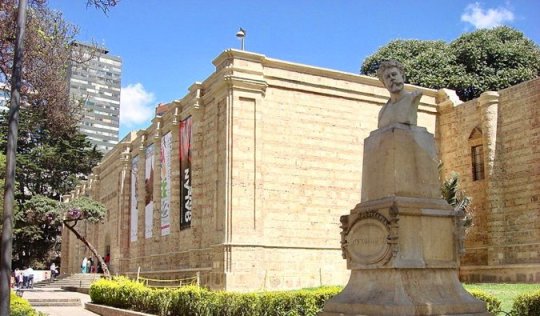
Situated in the heart of Bogotá, this is the oldest and biggest museum in the entire country (and one of the oldest on the continent). Built in 1823, it’s home to over 20,000 pieces of art and historical artifacts, some dating as far back as 10,000 BCE. The building was actually used as a prison initially (it definitely looks imposing) until it transitioned into a museum in 1946. If you’re a history buff or just want to learn more about the country, this museum is a must.
Carrera 7 No 28-66, +57 1-381-6470, museonacional.gov.co. Open Monday-Saturday 10am-6pm and Sundays 10am-5pm. Admission is 4,000 COp for adults, 3,000 COP for students, and 2,000 COP for children aged 5-12.
15. Wander the Usaquén Market

Every Sunday, artisans line the cobblestoned streets to sell all sorts of local crafts and goods. While it’s usually referred to as a flea market, things here are a bit nicer and more upscale than some of the other markets. It’s still quite affordable, though, and makes for a fun way to spend the day.
The market runs 11am-4pm every Sunday in Usaquén.
16. Explore the Museo Santa Clara
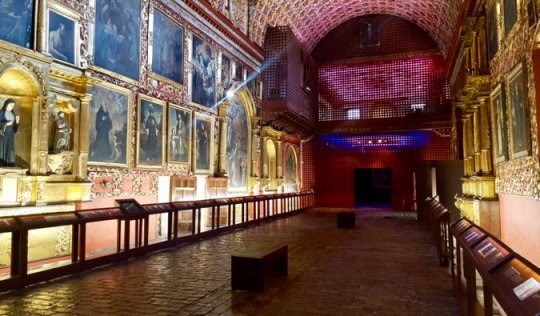
This church was built in the 17th century and is actually one of the oldest in the entire country. It was deconsecrated in the 1960s and converted into a museum by the government. There are over 148 baroque paintings that almost entirely cover its walls, making this one of the most beautifully decorated churches you’ll see in Colombia.
Cra. 8 No. 8-91, +57 1-337-6762, museocolonial.gov.co. Open Tuesday-Friday 9am-4:30pm and Saturday-Sunday 10am-3:30pm. Admission is 4,000 COP for adults and 2,000 COP for children.
17. Grab a snack from La Puerta Falsa
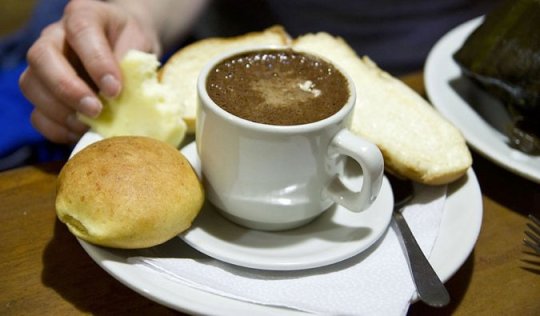
This little shop has been serving locals for over 200 years! La Puerta Falsa (The False Door) is a small restaurant with room for fewer than 20 people, yet the tamales and ajiaco soup have been community staples for generations. If you’re looking to try traditional Colombian food, this is the place to go!
Calle 11 No. 6-50, +57 1-286-5091, restaurantelapuertafalsa.inf.travel. Open daily 7am-10pm though its schedule isn’t set in stone.
18. Visit the Iglesia de San Francisco

Built in the 16th century, this Catholic church is the oldest surviving church in Bogotá. The interior is incredibly ornate, with a beautiful altar that dates back to the 17th century. It’s still in use, and you’ll likely see some locals praying during your visit, so make sure to dress appropriately and be respectful.
Av. Jimenez De Quesada No. 7-10, +57 1-341-2357. Open Monday-Friday 6:30am-10:30pm; 6:30am-12:30pm and 4pm-6:30pm on Saturdays; and 7:30am-1:30pm and 4:30-7:30pm on Sundays. Admission is free.
19. Sample the local brews
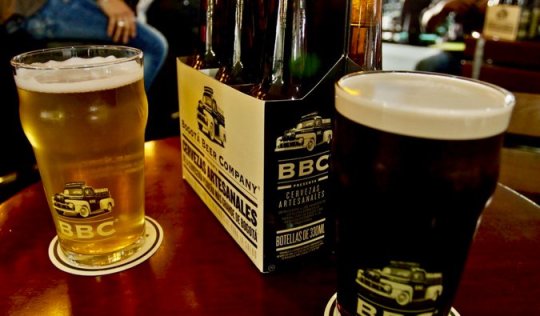
Bogotá (and the country has a whole) has a growing craft beer scene. Bogotá Craft Beer offers a four-hour tour that takes you to some of the best bars and breweries in town. The tour includes a knowledgable guide as well as secure transportation from place to place. I highly recommend it.
Tours are available daily 4pm-9pm and need to be booked in advance via their website. Tickets are around 95,000 COP per person.
20. Take a food tour

Bogotá is a great city for foodies, and the best way to get a sense of the culinary offerings is to take a food tour. Bogotá Food Tour will take you around La Macarena, Bogotá’s bohemian and artistic neighborhood. The tour lasts three hours and will take you to three different restaurants where you can sample a local dish and drink. Tours also include pickup and drop-off at your accommodation.
Tours are available Monday-Saturday and begin around 7pm. Booking in advance is required so you can secure your transportation. Tickets are 188,500 COP per person.
***
It’s true that Bogotá is an “edgy city” with a lot of petty crime. Yet I loved the atmosphere and vibe of the city. It had grit (kind of like Naples, Italy). I loved the art, the museums, the food. The city has so much to offer travelers. You can really fill a lot of time between all the sights, tours, parks, and activities. I would have liked to stay longer in Bogotá if I could.
I’d budget three to five days for your visit. It will definitely be worth it.
Book Your Trip to Colombia: Logistical Tips and Tricks
Book Your Flight Find a cheap flight by using Skyscanner or Momondo. They are my two favorite search engines because they search websites and airlines around the globe, so you always know no stone is being left unturned.
Book Your Accommodation You can book your hostel with Hostelworld. If you want to stay somewhere other than a hostel, use Booking.com as they consistently return the cheapest rates for guesthouses and cheap hotels. I use them all the time. My favorite places to stay are:
Masaya Hostel – This is a cool hostel located in La Candaleria. It has lots of common space where you can meet people and some comfy hammocks you can relax in; it also hosts all sorts of activities and excursions, from live music to salsa lessons.
Botánico Hostel – This cool hostel is relvatively new. The beds are comfy, it’s in a good location, and it offers free breakfast too!
Don’t Forget Travel Insurance Travel insurance will protect you against illness, injury, theft, and cancellations. It’s comprehensive protection in case anything goes wrong. I never go on a trip without it, as I’ve had to use it many times in the past. I’ve been using World Nomads for ten years. My favorite companies that offer the best service and value are:
World Nomads (for everyone below 70)
Insure My Trip (for those over 70)
Looking for the best companies to save money with? Check out my resource page for the best companies to use when you travel! I list all the ones I use to save money when I travel — and I think they will help you too!
Want More Information on Colombia? Be sure to visit our robust destination guide on Colombia for even more planning tips!
Photo credits: 13, 14, 15, 16, 17, 18, 21, 20, 21
The post 20 Things to See and Do in Bogotá appeared first on Nomadic Matt's Travel Site.
source https://www.nomadicmatt.com/travel-blogs/things-to-see-and-do-in-bogota/
0 notes